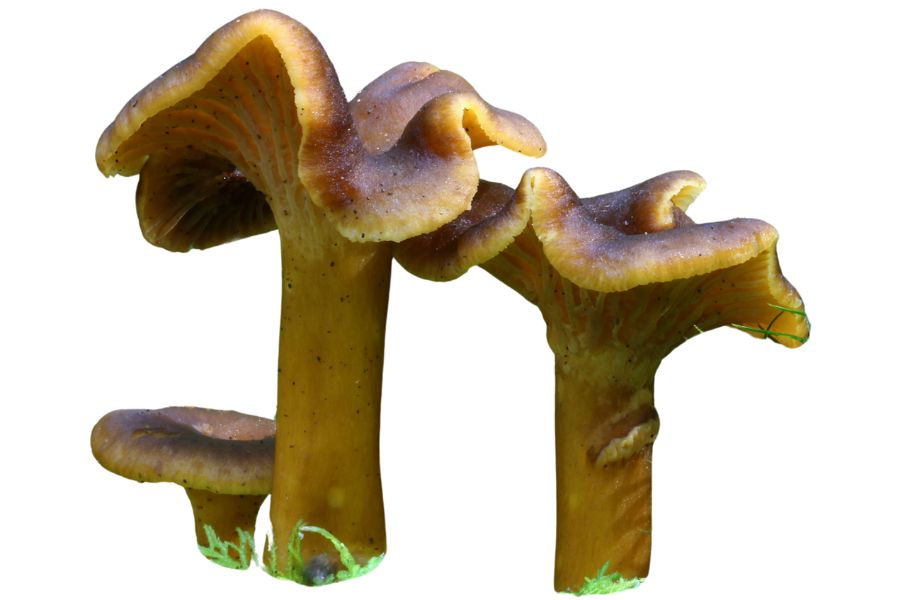Edible mushrooms grow in all kinds of places across California, from shady groves to damp creek beds. You might find shaggy manes rising from roadside soil or stumble onto a cauliflower mushroom in deep forest duff. Their variety keeps things interesting, even for those who’ve been foraging for years.
Some species only appear after just the right amount of rain. Others thrive in dry stretches and fruit in places most people wouldn’t think to look. That mix of timing and location means each trip offers a different chance.
With so many edible species growing here, it’s easy to miss something valuable without meaning to. The more you recognize, the more options you’ll start to see. A good eye and some knowledge can lead to an unexpectedly full basket.
You will have everything you need to track down the right mushrooms, and if you want to search for good rocks and minerals at the same time, one tool makes that simple.
Rock Chasing’s California Rocks & Minerals Identification Field Guide helps you sort out every interesting stone you pick up so you never walk past something special without realizing it.
What We Cover In This Article:
- The Edible Mushrooms Found in the State
- Edible Mushroom Lookalikes to Avoid
- How to Find Edible Mushrooms in the State
- Best Locations for Edible Mushrooms in the State
- Peak Mushroom Seasons
- The extensive local experience and understanding of our team
- Input from multiple local foragers and foraging groups
- The accessibility of the various locations
- Safety and potential hazards when collecting
- Private and public locations
- A desire to include options for both experienced foragers and those who are just starting out
Using these weights we think we’ve put together the best list out there for just about any forager to be successful!
A Quick Reminder
Before we get into the specifics about where and how to find these plants and mushrooms, we want to be clear that before ingesting any wild plant or mushroom, it should be identified with 100% certainty as edible by someone qualified and experienced in mushroom and plant identification, such as a professional mycologist or an expert forager. Misidentification can lead to serious illness or death.
All plants and mushrooms have the potential to cause severe adverse reactions in certain individuals, even death. If you are consuming wild foragables, it is crucial to cook them thoroughly and properly and only eat a small portion to test for personal tolerance. Some people may have allergies or sensitivities to specific mushrooms and plants, even if they are considered safe for others.
The information provided in this article is for general informational and educational purposes only. Foraging involves inherent risks.
The Edible Mushrooms Found in the State
Many types of edible mushrooms grow across the state, depending on the region and time of year. Some are easy to recognize, while others require a more experienced eye.
These are some of the most sought-after edible mushrooms that grow in different parts of the state:
Porcini (Boletus edulis)
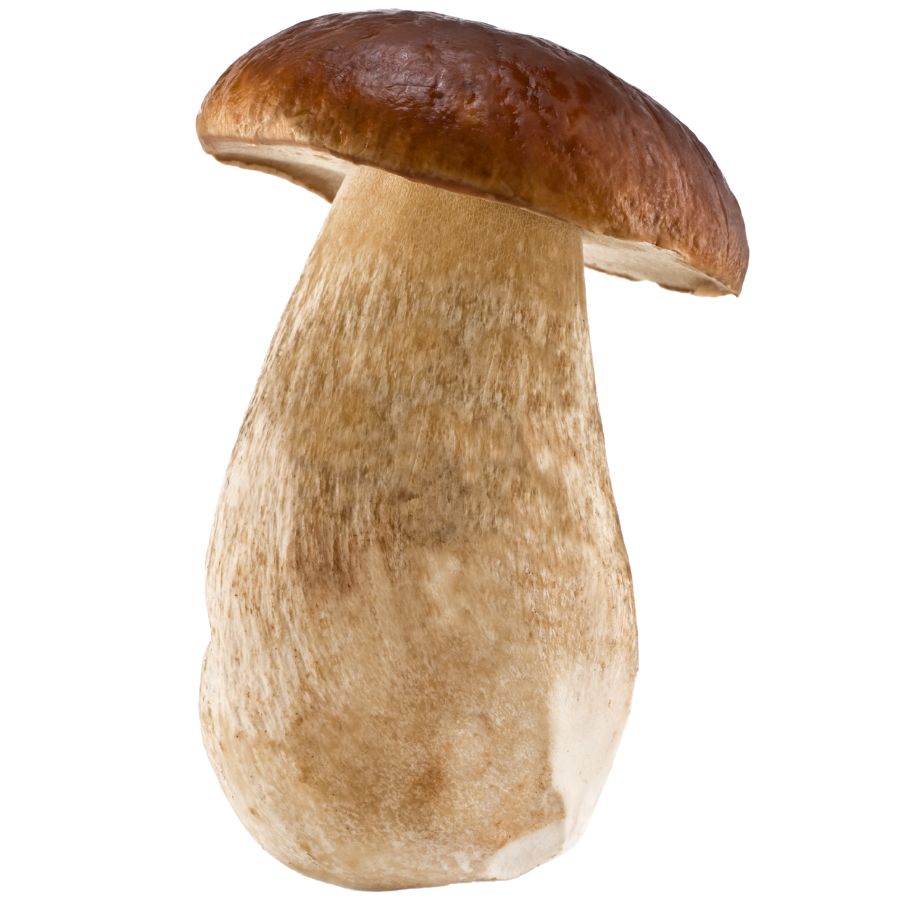
Porcini mushrooms, also known as king boletes or penny buns, are thick and meaty with a smooth brown cap and a pale, swollen stem. The underside of the cap has white to yellowish pores instead of gills, and they don’t bruise easily when handled.
You’ll want to be careful not to confuse porcini with bitter bolete or the poisonous Boletus satanas. Porcini have a pleasant, nutty smell and white flesh that doesn’t change color when sliced, which helps set them apart.
They’re prized for their rich, savory flavor and firm texture, which holds up well in cooking. You can sauté them in butter, dry them for soups and stews, or slice them fresh into pasta dishes.
Keep in mind that porcini often host insects, especially in the stem, so it helps to cut them open and check before cooking. They’re a favorite among chefs and foragers alike, and they’ve been valued in European cuisine for centuries.
Most people don’t realize how many incredible rocks California hides in its mountains, deserts, and beaches. This guide shows exactly what you’ve been walking past.
🌈 300+ color photos of real California specimens
🪨 Raw + polished examples make identification simple
🏜️ Covers coastlines, gold country, Sierras & more
💦 Waterproof pages built for real outdoor use
Chanterelle (Cantharellus cibarius)

Golden chanterelles, also known as egg yolk mushrooms or forest gold, have a bright yellow to orange color with a funnel-shaped cap and thick, wavy edges. You’ll notice that the underside has shallow ridges instead of true gills, and they run down the stem.
A few toxic mushrooms look similar, including the jack-o’-lantern mushroom, which grows in clusters and has true gills that don’t fork or run down the stem. If you rub a chanterelle and it smells fruity or like apricots, that’s a good sign you’ve got the real thing.
The taste is mild, earthy, and a little peppery, with a firm but smooth texture that holds up well in cooking. Chanterelles are often sautéed in butter, added to cream sauces, or used in soups and egg dishes.
They don’t dry well, so you’ll want to use them fresh, or store them briefly in the fridge wrapped in paper. These mushrooms often grow in the same spots year after year, so if you find a patch, it’s worth checking again the next season.
Cauliflower Mushroom (Sparassis crispa)
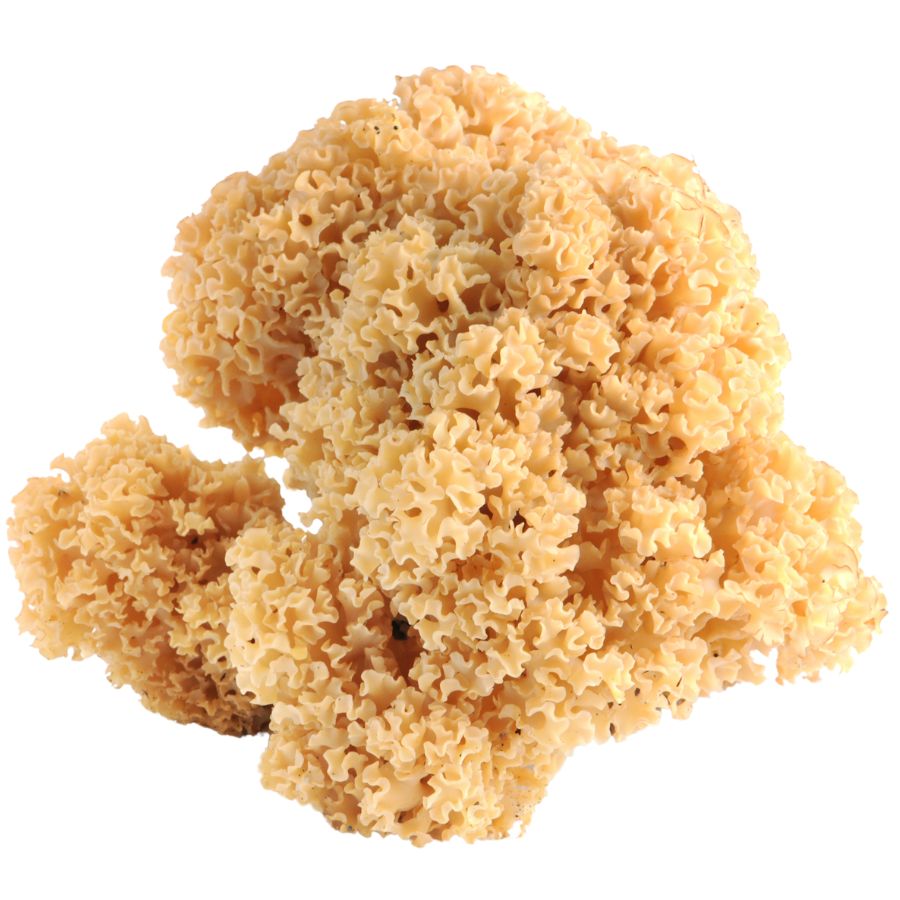
You might hear cauliflower mushrooms called wood cauliflower or noodle mushroom, and they really live up to those names. They grow in large, tangled clumps that look like ruffled egg noodles or a big head of cauliflower, usually near the base of conifers.
It’s pretty hard to mistake this one once you’ve seen it, but some beginners confuse it with old or decaying coral fungi, which are usually more brittle and branch-like. Cauliflower mushrooms have a soft, flexible feel and a pale cream to yellowish color that stays consistent as they mature.
When you cook it, it has a slightly nutty, mild flavor with a texture that stays pleasantly chewy. Most people sauté it or add it to soups, but it also dehydrates well if you want to save some for later.
Before you cook it, make sure to clean it well because dirt and bugs like to hide deep in the folds. It’s a fun one to forage, not just because of the taste, but because the clusters can get surprisingly large, sometimes weighing several pounds.
Lion’s Mane (Hericium erinaceus)
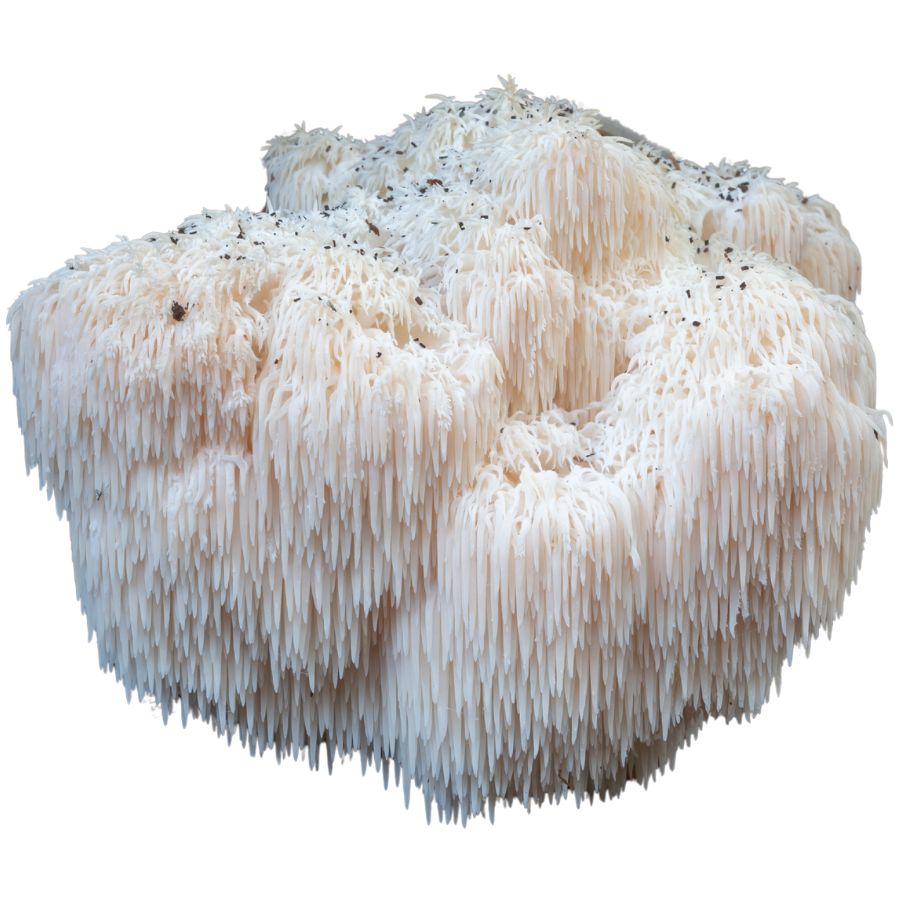
Lion’s mane, also called bearded tooth or pom pom mushroom, is easy to spot thanks to its cascading white spines that look a bit like a frozen waterfall. It usually grows on dead or dying hardwood trees and forms round, shaggy clumps that almost glow against the bark.
If you’re checking for lookalikes, you might run into other Hericium species like bear’s head or comb tooth, but none of them are toxic. Just make sure the spines are soft, white, and at least a quarter inch long, and avoid anything discolored or slimy.
Lion’s mane has a firm, meaty texture and a mild flavor that some people say reminds them of seafood, especially crab or lobster. You can sauté it, roast it, or even shred it as a meat substitute in sandwiches and tacos.
Some people also dry lion’s mane or take it as a supplement, since it’s being studied for possible benefits to memory and focus. There aren’t any serious safety concerns with eating it, but it’s still best to cook it thoroughly and start with a small amount the first time.
Black Morel (Morchella elata)
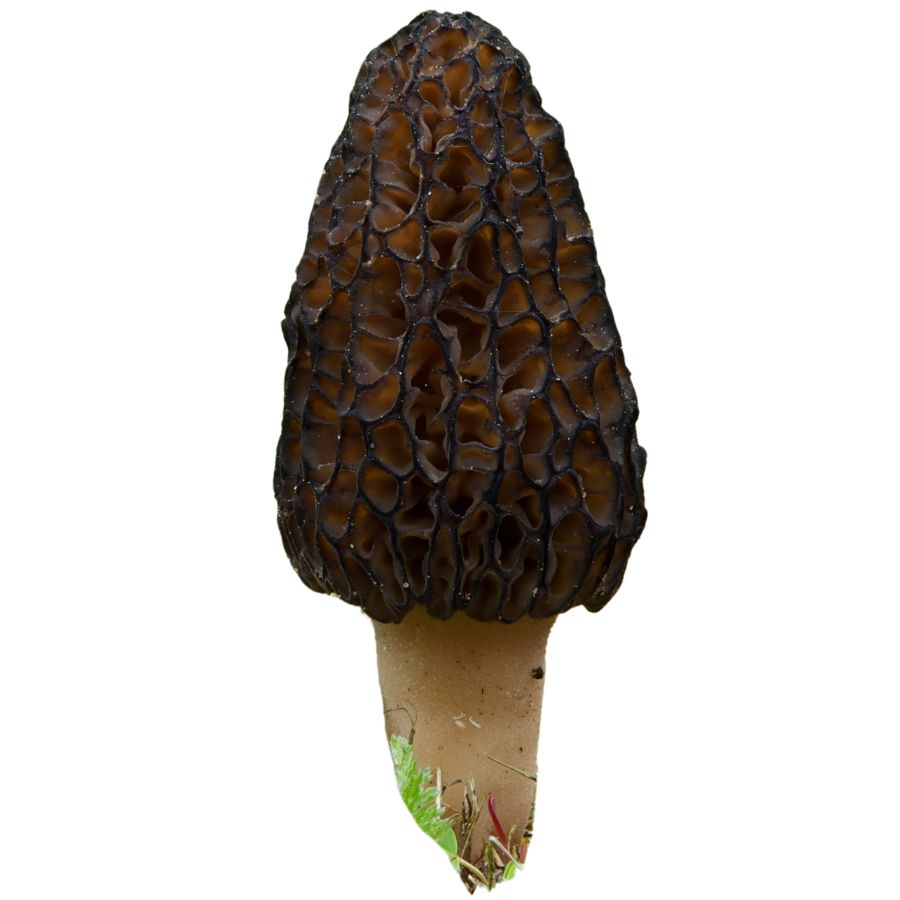
Black morels, also called fire morels or conica morels, have a dark, ridged cap that looks almost like a pinecone. The cap is fully attached to the stem, and both are hollow from top to bottom when sliced open.
One thing to watch for is false morels, which can be toxic and have wrinkled, lobed caps that don’t form deep pits. You’ll also notice that false morels aren’t completely hollow and their caps hang loosely from the stem rather than connecting fully.
When cooked, black morels have a rich, nutty flavor and a slightly chewy texture that holds up well in sauces or sautés. Many people dry them to preserve their flavor and use them later in broths or pasta dishes.
These mushrooms often show up in burn areas a year or two after a wildfire, which makes them especially prized among foragers. Just make sure to always cook them thoroughly, as eating them raw can cause stomach upset.
Black Trumpet (Craterellus cornucopioides)
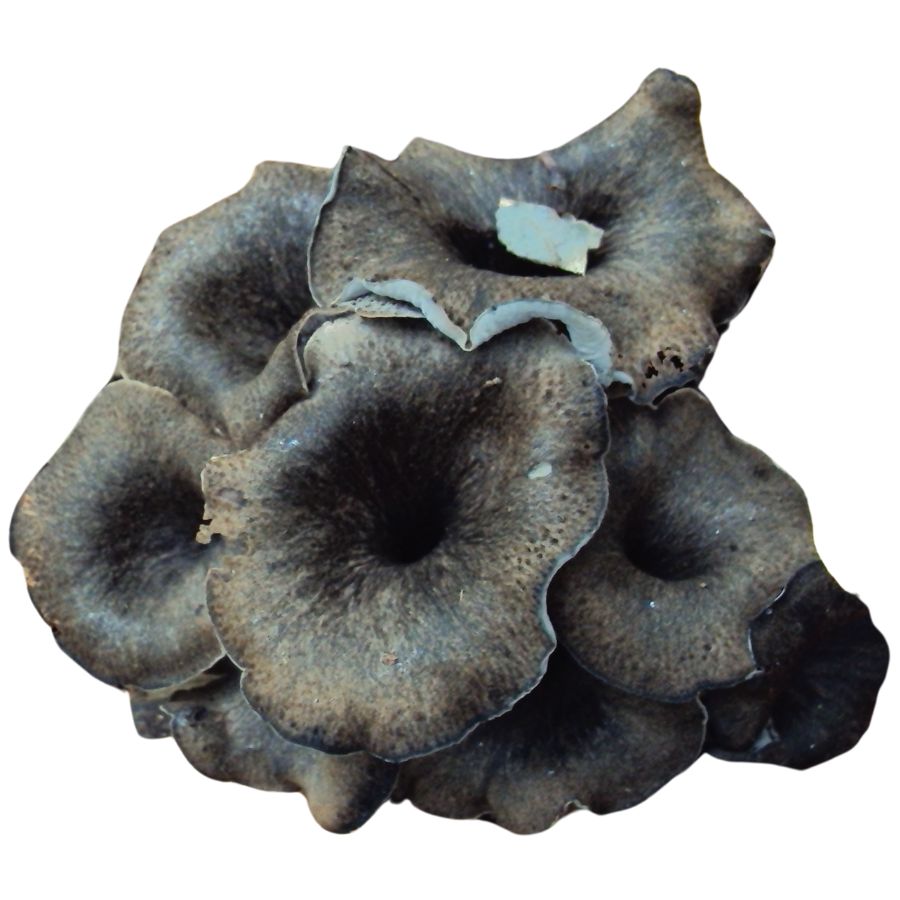
Black trumpet mushrooms are also called horn of plenty or trumpet of the dead, but don’t let the spooky name fool you. These mushrooms are completely edible and prized for their smoky, rich flavor that intensifies when dried.
You’ll recognize them by their dark, funnel-shaped bodies that often blend in with the forest floor. They don’t have gills, just smooth, wrinkled undersides and thin, fragile flesh that curls outward at the edge.
This mushroom doesn’t have many dangerous lookalikes, but some cup fungi or small black earth tongues might cause confusion. The main difference is that black trumpets grow hollow and thin-walled, while most lookalikes are solid or rubbery.
You can sauté them, dry them for long-term storage, or grind them into a seasoning powder that adds deep flavor to soups and pasta. Just make sure to clean them carefully since their folds and tubes can hold bits of grit and debris.
Queen Bolete (Boletus aereus)

The queen bolete, also called the bronze bolete or black porcini, is a dense and flavorful wild mushroom prized by foragers and chefs alike. You’ll recognize it by its dark brown cap that can look nearly black when wet, and its thick, pale stalk with fine netting near the top.
This mushroom is known for its rich, nutty flavor and meaty texture that holds up well when sautéed, grilled, or dried for later use. It’s considered one of the best-tasting boletes, even compared to porcini (king bolete), and is a favorite in soups, pasta dishes, and risottos.
One of the easiest ways to mix it up with something inedible is mistaking it for a bitter bolete or one of the Tylopilus species, which may look similar but taste unpleasant. Look for the white pores that eventually turn yellowish and avoid any boletes with red or orange pore surfaces, which can indicate a toxic species.
You won’t find queen boletes growing just anywhere. They typically fruit in warmer, dry oak forests and are less common than some of the other edible boletes, making them a special find when you do come across them.
Candy Cap (Lactarius rubidus)
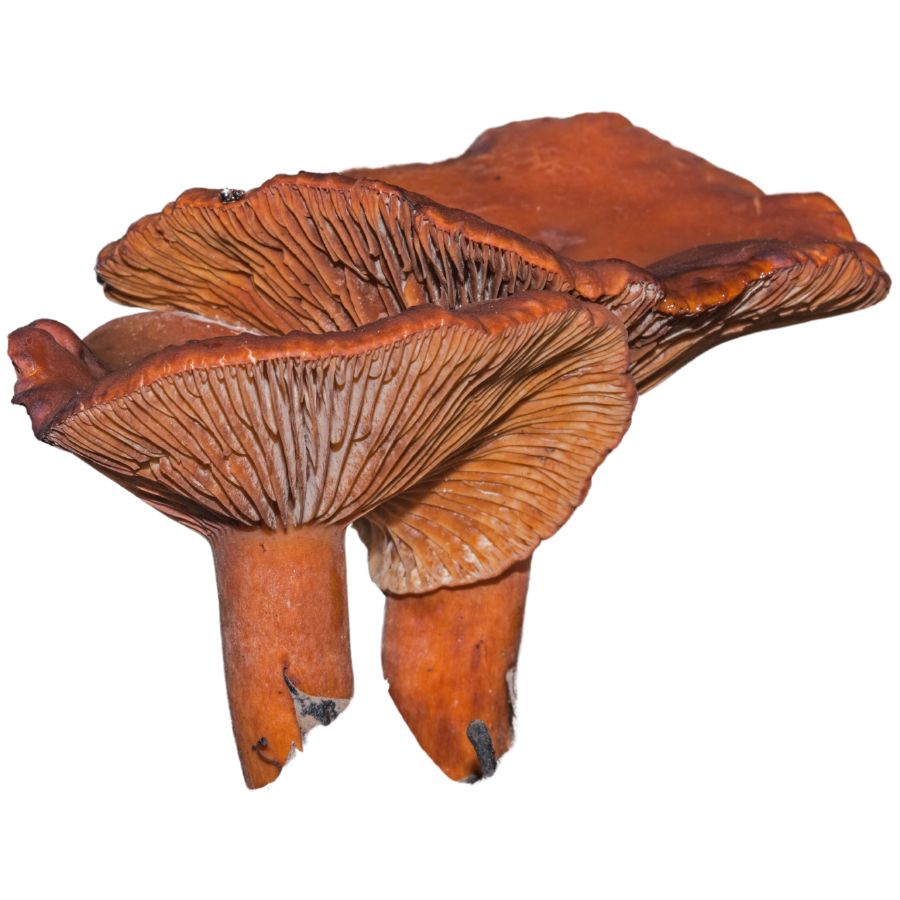
Candy caps are small reddish-brown mushrooms that can blend in with leaf litter, but once you smell them, you’ll know. When dried, they have a strong maple syrup scent that makes them one of the most uniquely fragrant wild mushrooms you can find.
You’ll sometimes hear them called maple mushrooms, and that’s not just a nickname. That maple scent sticks around in your kitchen and your food, and it’s why people love using candy caps in baked goods and desserts.
One thing to watch out for is that there are similar-looking Lactarius mushrooms that don’t smell sweet and can upset your stomach. If you don’t get that maple aroma, don’t eat it.
Most people dry candy caps to bring out the flavor, then crumble or steep them into cream, butter, or sugar. Some also use them in savory sauces, but they really shine in cookies and ice cream.
Oyster Mushroom (Pleurotus ostreatus)
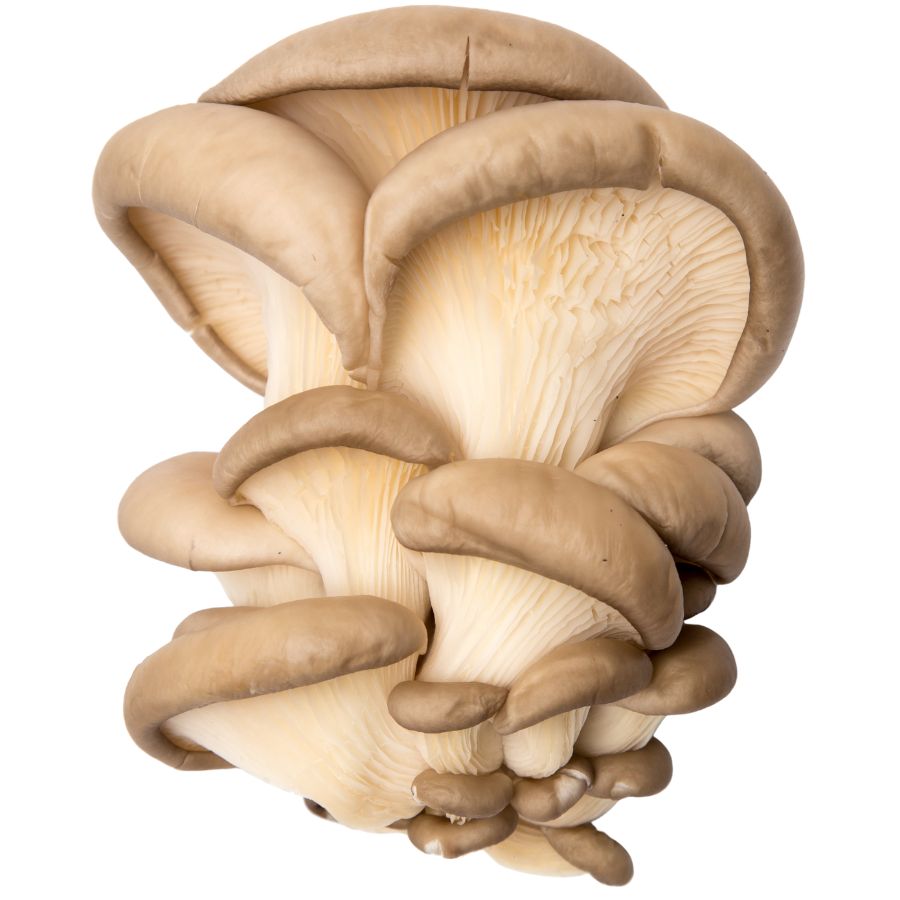
Oyster mushrooms are also called tree oysters or pearl oysters, and they’re known for their wide, shelf-like caps that resemble oyster shells. They usually grow in clusters on dead or dying hardwood and come in shades of white, gray, or pale brown, with creamy white gills that run down the stem.
You can recognize them by their smooth, fan-shaped caps and their mild, anise-like scent. One common lookalike is the toxic jack-o’-lantern mushroom, which grows in clumps like oysters but has orange coloring and glows faintly in the dark.
Oyster mushrooms have a soft, slightly chewy texture and a delicate, savory flavor that works well in stir-fries, soups, or simply sautéed in butter. They’re also good for drying or freezing, and some people pickle them to enjoy later in the season.
These mushrooms are used in some parts of the world for medicinal purposes and even in research for breaking down pollutants. While they’re generally safe to eat, they can cause digestive issues in some people if undercooked, so make sure to cook them thoroughly before eating.
Shaggy Mane (Coprinus comatus)
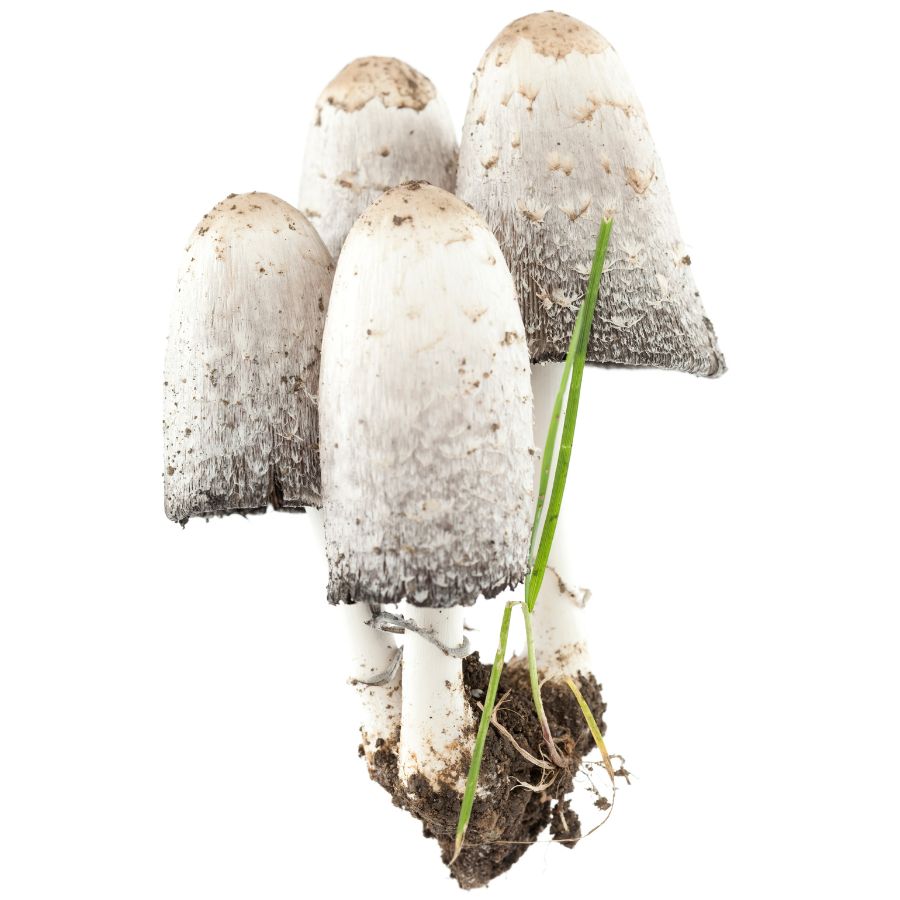
Shaggy mane mushrooms are also known as lawyer’s wig thanks to their tall, cylindrical caps covered in shaggy white scales. They often appear in lawns, meadows, or along roadsides and are most common after rain in cooler months.
These mushrooms are easy to recognize when fresh, but they quickly start to “melt” into a black, inky liquid as they age. That process, called deliquescence, is one of the main features that separates them from lookalikes like the inedible inky caps which are usually smaller and darker from the start.
Shaggy manes have a mild, pleasant flavor and a tender texture when cooked, but they don’t store well so you’ll want to use them the same day you pick them. Many people enjoy them sautéed, added to omelets, or mixed into cream-based sauces.
You shouldn’t eat shaggy manes with alcohol, since some people report reactions similar to those caused by certain inky caps. They’re one of the few mushrooms that actually taste best before the cap opens fully, so harvest them while they still look like white rockets.
Comb Tooth (Hericium coralloides)

Comb tooth mushrooms are sometimes called coral tooth or cascading hedgehog, and they really do look like a frozen waterfall of white icicles. Each branch is covered in soft, dangling spines that hang downward in delicate clusters.
There are very few lookalikes, but it’s important not to confuse this with decaying white fungus or certain mold-like growths that form on rotting wood. Comb tooth always grows in an organized, coral-like pattern, and the spines should feel soft, never slimy.
When cooked, this mushroom has a texture similar to crab or scallops and takes on a mild, nutty flavor. It holds up well in stir-fries, soups, or even sliced thick and seared like seafood.
Some people dehydrate comb tooth to preserve it, while others freeze it after lightly sautéing. It’s also been studied for its potential benefits to nerve health, though it’s mainly prized for its taste and texture.
Wood Blewit (Clitocybe nuda)
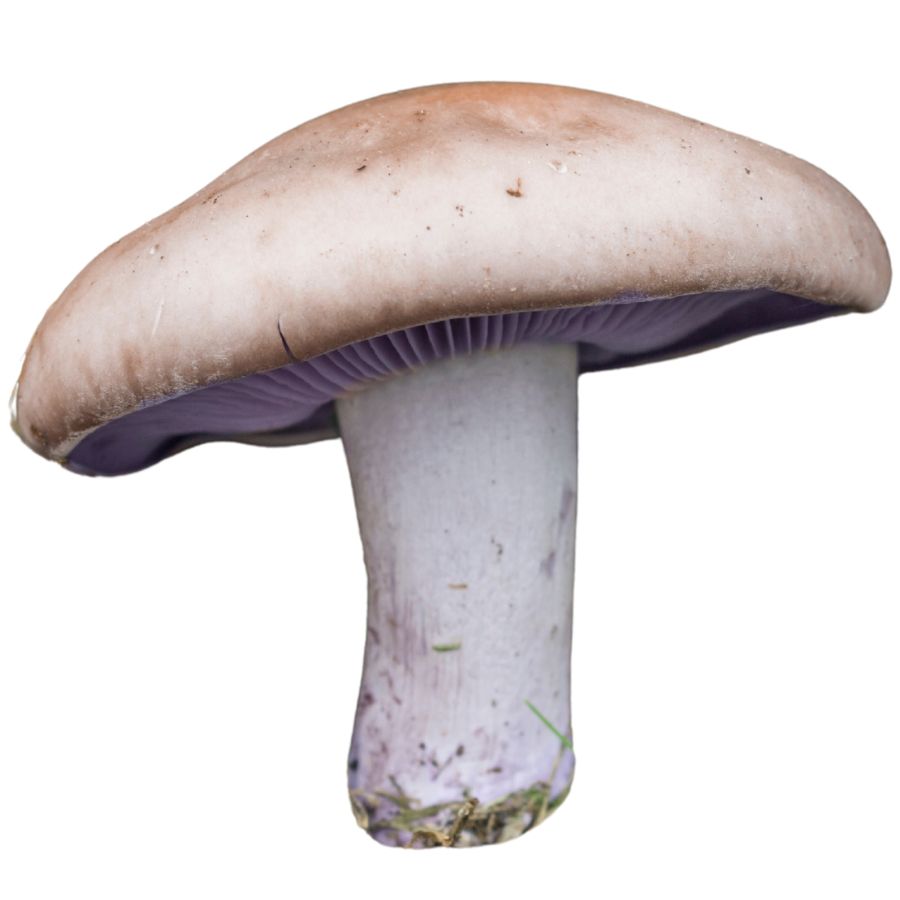
Wood blewits are often called blewits or blue-legs, and they stand out thanks to their pale lilac to violet caps and matching stems. As they age, the colors fade to a duller tan, but the hint of purple often remains on the gills and stem base.
You’ll want to be careful not to confuse them with some Cortinarius species, which can also have purplish tones but often have rusty brown spores and a cobweb-like veil. The spore print is a reliable way to tell them apart—wood blewits leave a pale pink print, while the toxic Cortinarius species tend to leave rusty brown ones.
Blewits have a rich, earthy flavor and a dense, meaty texture that holds up well in sautés, soups, and sauces. They’re usually cooked right after harvesting or stored in the fridge for a few days, but they can also be dried or frozen after cooking.
It’s important to cook blewits thoroughly, as they can cause stomach upset if eaten raw. Some people are also sensitive to them even when cooked, so try a small amount the first time just to be safe.
Meadow Mushroom (Agaricus campestris)
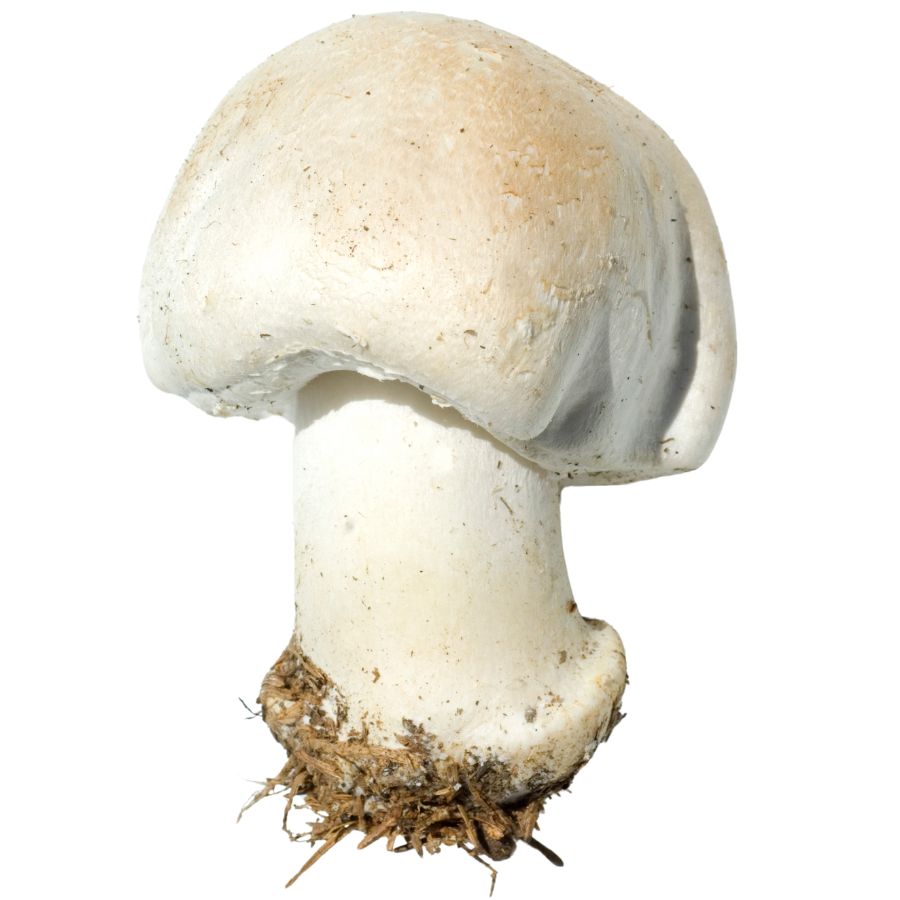
Meadow mushrooms are sometimes called pink bottoms or field mushrooms. They usually have a smooth white cap that stays round before flattening out as they mature, with pale pink gills that darken to chocolate brown.
You’ll want to double-check before harvesting because they can look a lot like some toxic Amanitas. One of the easiest ways to tell them apart is by the gill color and the strong, pleasant mushroom smell meadow mushrooms have.
These mushrooms have a mild, nutty flavor and a firm texture that holds up well in cooking. You can sauté them, add them to stews, or even dry them for later use.
Some people with mushroom sensitivities might react to them, especially when they’re eaten raw. Always cook meadow mushrooms thoroughly and avoid harvesting them from areas with chemical exposure like lawns or roadsides.
The Prince (Agaricus augustus)
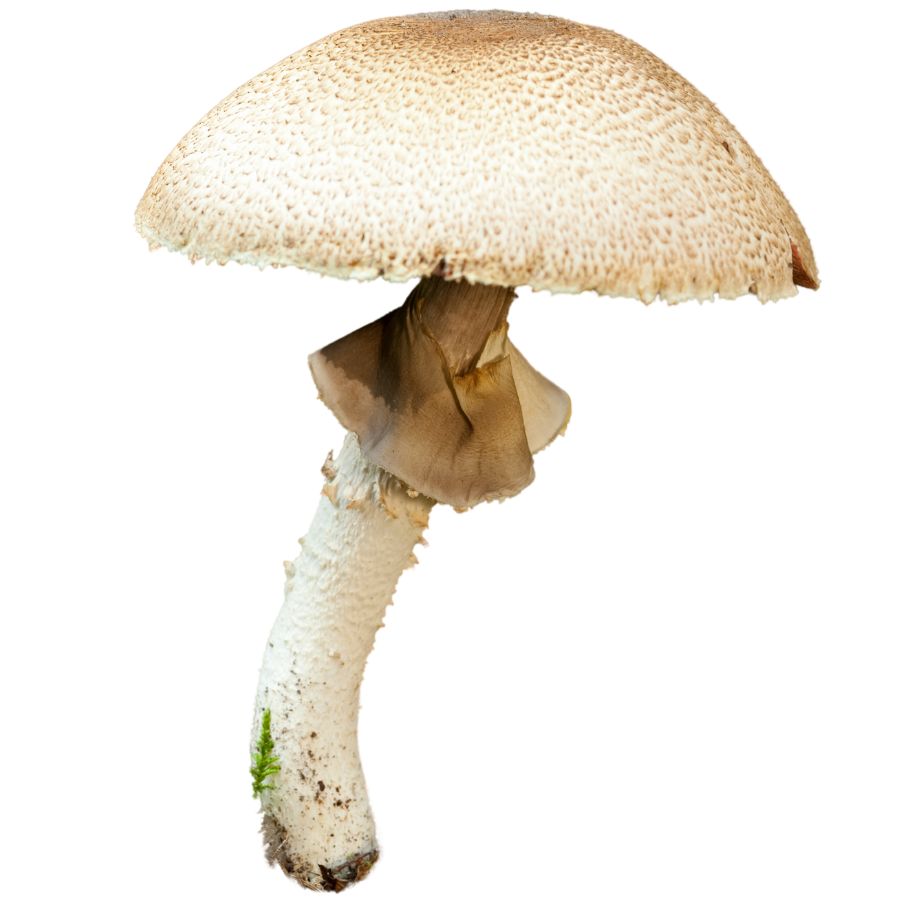
The prince is a large, showy mushroom that’s also known as the almond mushroom. It has a thick white stem and a cap covered in brownish scales, and it gives off a sweet, almond-like smell when it’s fresh.
You can tell it apart from toxic lookalikes like the yellow-staining Agaricus by cutting the base and checking for any bright yellow bruising. The prince will slowly stain a pale brown and not produce that strong inky or chemical smell that some inedible species do.
It has a rich, meaty flavor that many people compare to portobellos but with a sweeter finish. You can grill it, roast it, or slice it into pasta and risottos where its texture really stands out.
This mushroom can grow surprisingly large, sometimes big enough to fill a dinner plate. Just make sure to harvest young, firm specimens because older ones can get soggy and lose their flavor.
Yellowfoot (Cantharellus tubaeformis)
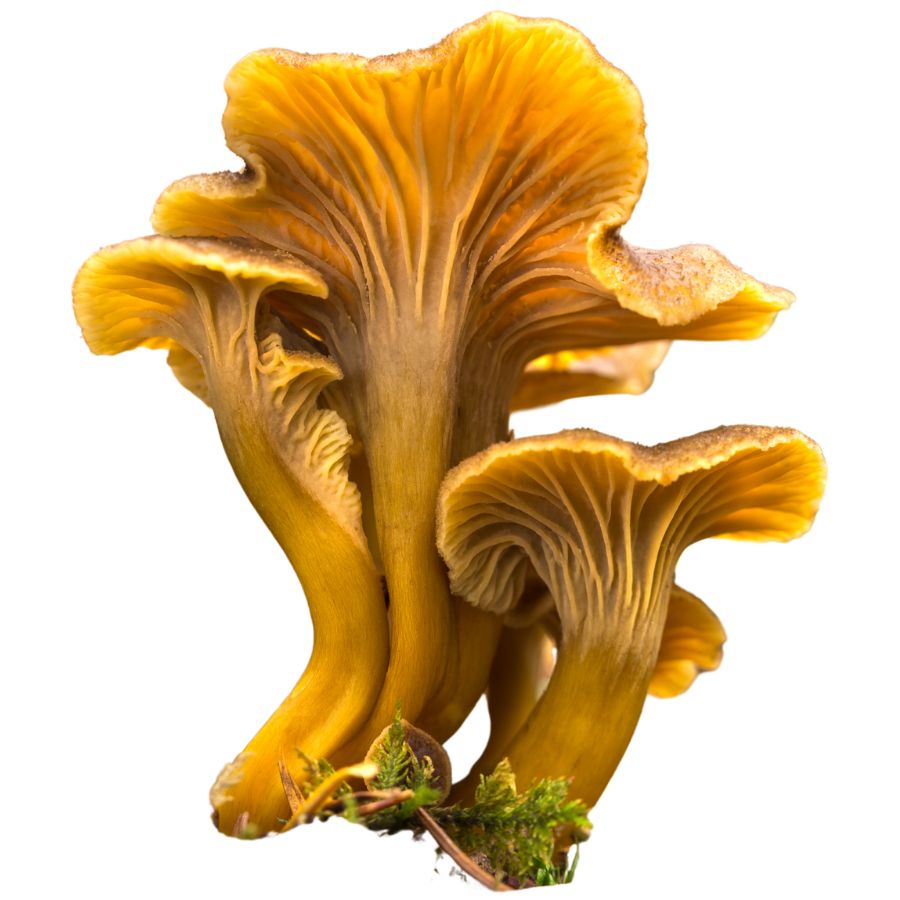
You might hear yellowfoot mushrooms called winter chanterelles or funnel chanterelles. They’re slender and trumpet-shaped, with brownish caps that curl inward and hollow yellow stems that help them stand out on the forest floor.
They’re often confused with some brownish Omphalotus or Galerina species, which are toxic, but yellowfoot have blunt-edged false gills that look more like wrinkles than true gills. Always double-check that the cap is smooth and the stem is hollow before collecting them.
Yellowfoot mushrooms have a delicate, fruity aroma and a mild, earthy flavor that holds up well in soups, risottos, and sautés. Their thin texture means they dry quickly and rehydrate easily, making them great for storing and using later.
These mushrooms often grow in clusters in damp conifer forests, especially during cooler months when other edible mushrooms are hard to find. If you’re out foraging and come across a patch, you’ll usually find a lot more nearby, so they’re worth seeking out.
Hedgehog Mushroom (Hydnum repandum)
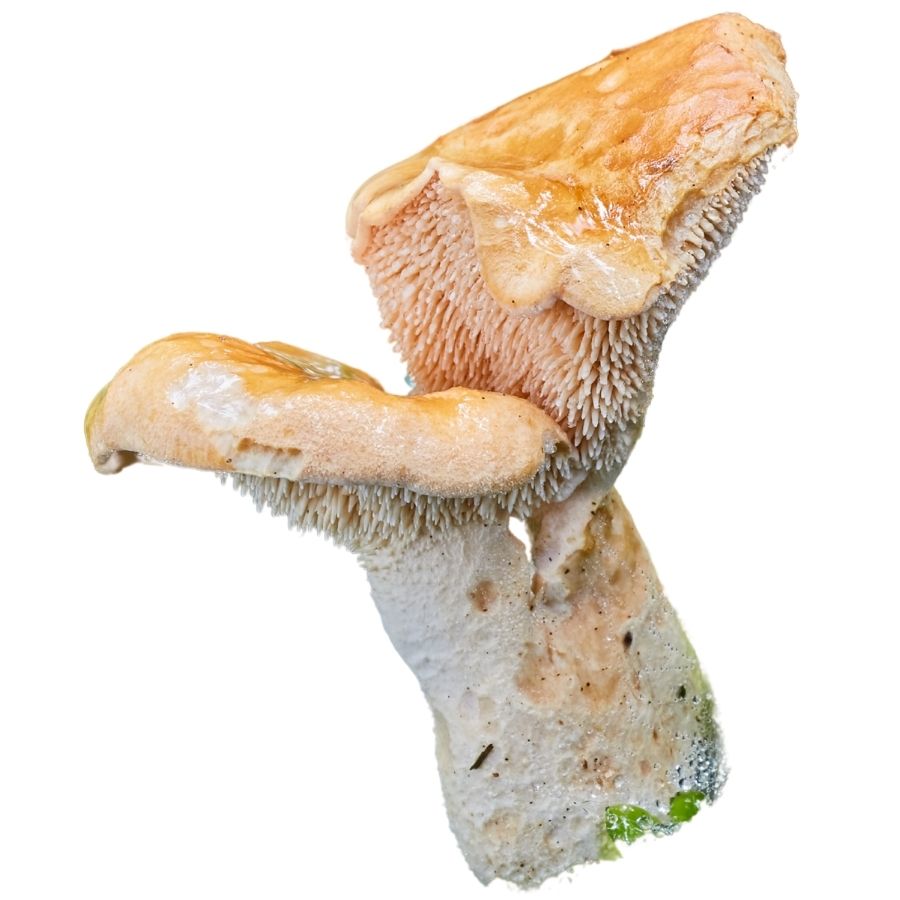
Hedgehog mushrooms are also called sweet tooth mushrooms, and they’re one of the easiest wild mushrooms to recognize. Instead of gills, the underside of the cap has soft, pale spines that resemble tiny teeth.
They’re usually creamy to light orange in color with thick, firm stems and a cap that can be wavy or lopsided. You’ll often find them growing in loose groups in mixed woodlands during the cooler months.
Their flavor is nutty and a little bit sweet, and the texture stays pleasantly firm even after cooking. They hold up well in sautés, stews, and even dry well for long-term storage without losing too much flavor.
Hedgehog mushrooms don’t have many toxic lookalikes, but you should still make sure you see those signature spines before collecting. They’re a great beginner-friendly mushroom and tend to be overlooked, which means you’re more likely to find some even in spots that have already been picked over.
Honey Mushroom (Armillaria mellea)
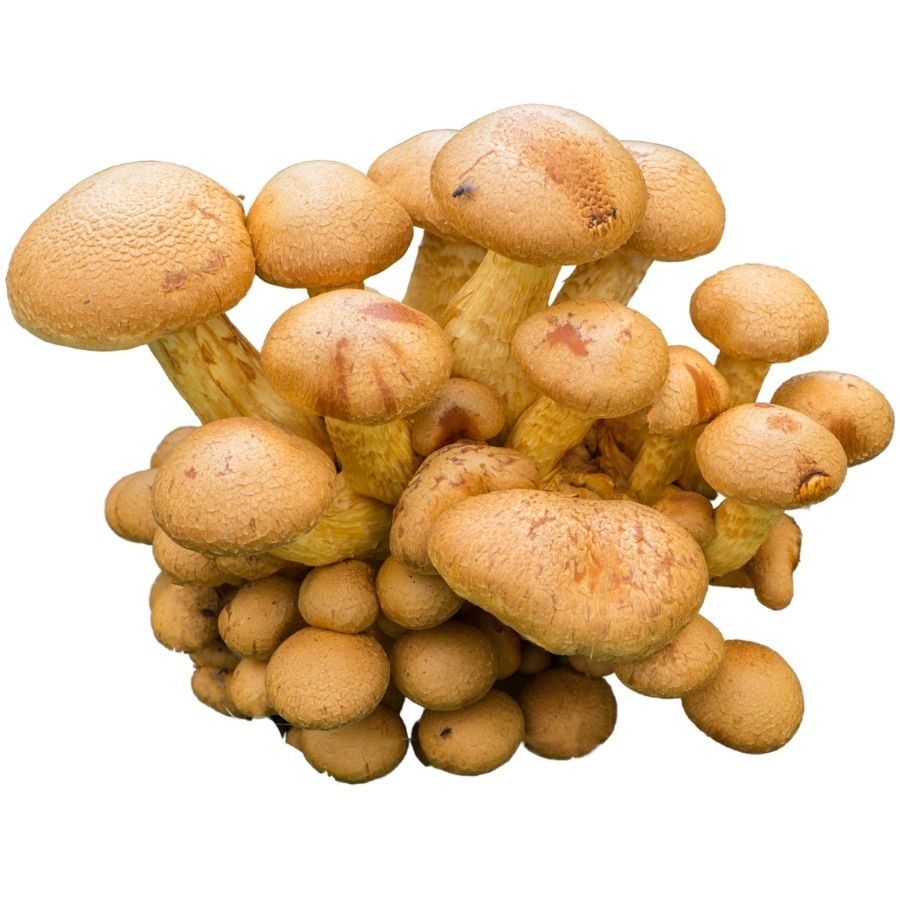
Honey mushrooms, sometimes called stump mushrooms or shoestring fungus, grow in clusters and have a smooth, honey-colored cap that darkens with age. The gills are white to yellowish and run slightly down the stem, which often has a ring near the top.
You might mistake them for deadly Galerina species, which are smaller, darker, and grow alone or in small groups. One way to tell them apart is to check the spore print: honey mushrooms have a white spore print, while Galerina’s is rusty brown.
When cooked, honey mushrooms have a firm texture and a mildly sweet, nutty flavor that pairs well with garlic and herbs. They’re commonly sautéed or added to soups and risottos, but they must always be cooked thoroughly to remove any bitterness or stomach-irritating compounds.
These mushrooms are also known for their role in forest ecosystems, since they grow on dead or dying wood and can spread underground through long black root-like structures. They can sometimes act as a tree parasite, so you may see them growing at the base of living trees.
Horse Mushroom (Agaricus arvensis)
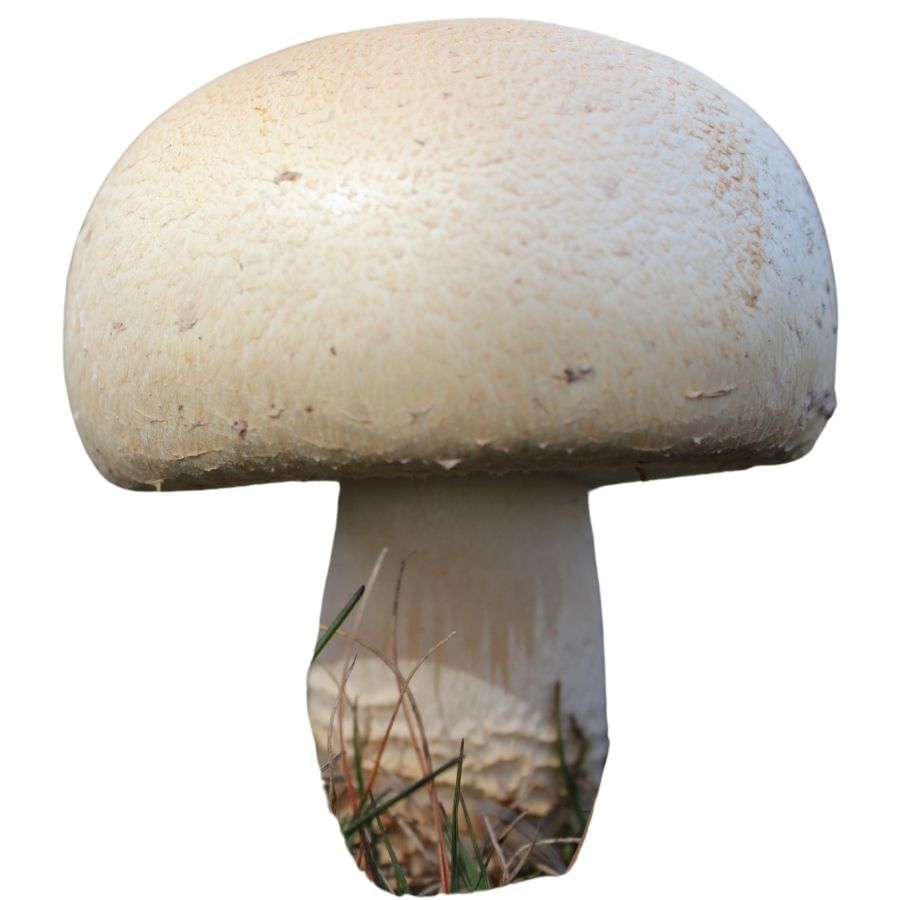
Horse mushrooms, also known as the “field giant” or “snowball mushroom,” are large, pale fungi with thick white stems and wide, creamy caps that can reach over six inches across. The gills start pale but darken to chocolate brown as the mushroom matures, which helps distinguish it from dangerous lookalikes.
One of the most important things to watch out for is the yellow-staining agaricus, which can look similar but bruises bright yellow and often smells unpleasant, like chemicals or ink. Horse mushrooms, on the other hand, bruise slowly and have a pleasant, slightly sweet anise-like smell.
The flavor is rich and savory, with a firm texture that holds up well when sautéed, grilled, or added to soups. Many people also dry them for later use, since they rehydrate well and keep their flavor.
Even though it’s edible, you should never eat it raw, and it can cause stomach upset in some people when undercooked. If you ever notice a strong chemical or inky smell instead of that almond scent, toss it out as it’s likely not the real deal.
Wild Enoki (Flammulina velutipes)
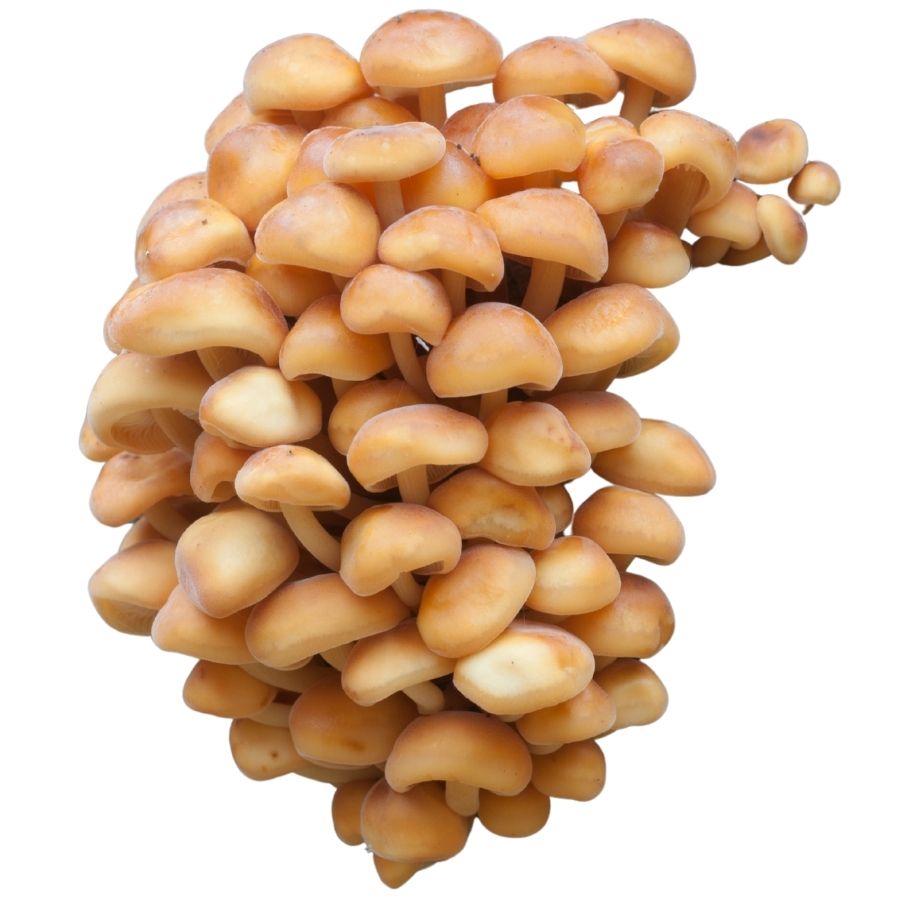
Wild Enoki mushrooms are also called velvet foot or golden needle mushrooms, and they’re easy to recognize once you know what to look for. They grow in tight clusters with long, thin white stems and small white or pale brown caps that stay rounded even when mature.
One of the easiest ways to tell enoki apart from dangerous lookalikes is its growth habit and the environment it’s found in. The wild version has darker caps and grows on decaying hardwood, while the cultivated kind is paler and grown in low-light conditions to keep it white and slender.
These mushrooms have a crisp texture when raw and stay slightly crunchy even after cooking. You’ll often find them in soups, stir-fries, hot pots, or lightly sautéed, and they also work well in cold dishes like salads.
Wild enoki can be confused with a toxic mushroom called the funeral bell, so it’s best to forage only if you’re absolutely sure of what you’re picking. If you’re foraging, be careful to check for key traits like the smooth white stem, the tightly packed cluster, and the white spore print to avoid any dangerous mix-ups.
Edible Mushroom Lookalikes to Avoid
It’s easy to confuse edible mushroom species with toxic ones that look surprisingly similar. Here’s a rundown of common mushroom lookalikes that you should learn to recognize and avoid.
Death Cap (Amanita phalloides)
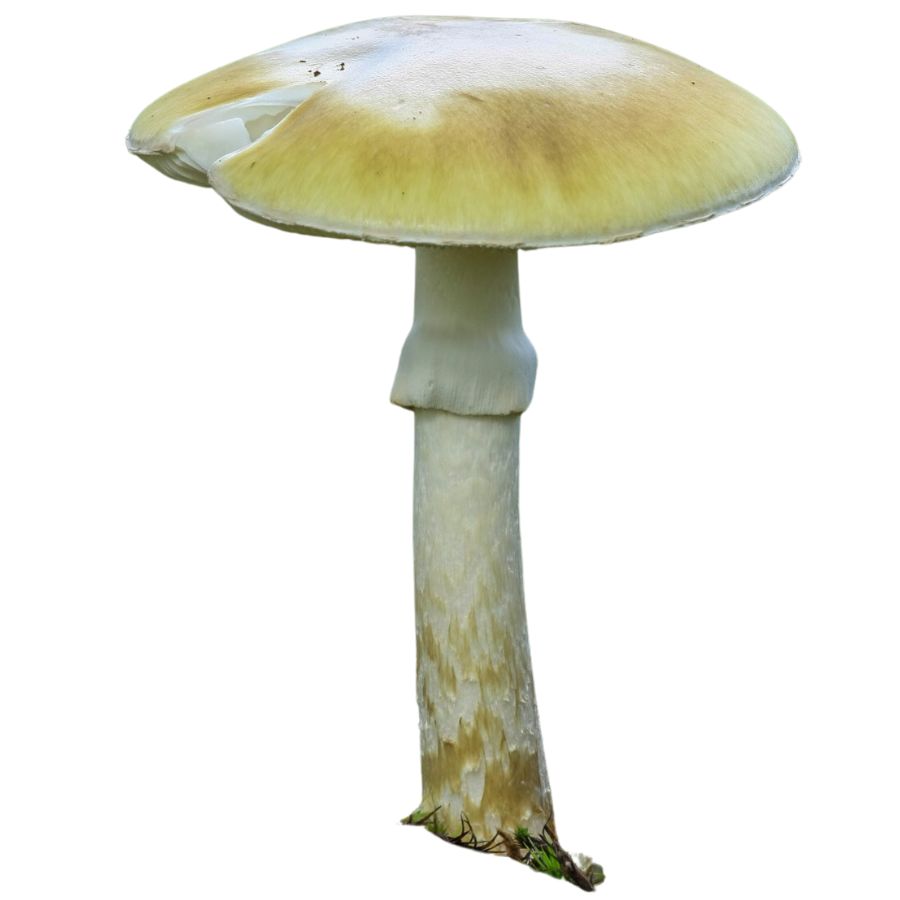
Often mistaken for: Paddy straw mushroom (Volvariella volvacea)
This deadly mushroom isn’t native but has naturalized in several parts of the US, especially California. It has a pale greenish or yellowish mushroom with a smooth, rounded cap and white gills underneath. It has a bulbous base often hidden underground and a delicate, skirt-like ring around the upper stem.
What makes the death cap dangerous is its amatoxins, which can cause liver and kidney failure even in small amounts. Symptoms may not show up for hours, and by then, serious damage may already be done—making this one of the deadliest mushrooms in the country.
If your kids constantly ask “What’s this rock?”, this guide finally gives you an answer you don’t have to Google later. Quick photos, simple descriptions, and rugged pages make ID’ing rocks fun instead of frustrating.
🔍 Fast visual matching—no geology background needed
💦 Wipe-clean pages made for creeks, beaches & dirt
📚 Simple explanations for beginners of all ages
🌄 Great for California hikes, creek beds & camping trips
False Morel (Gyromitra spp.)
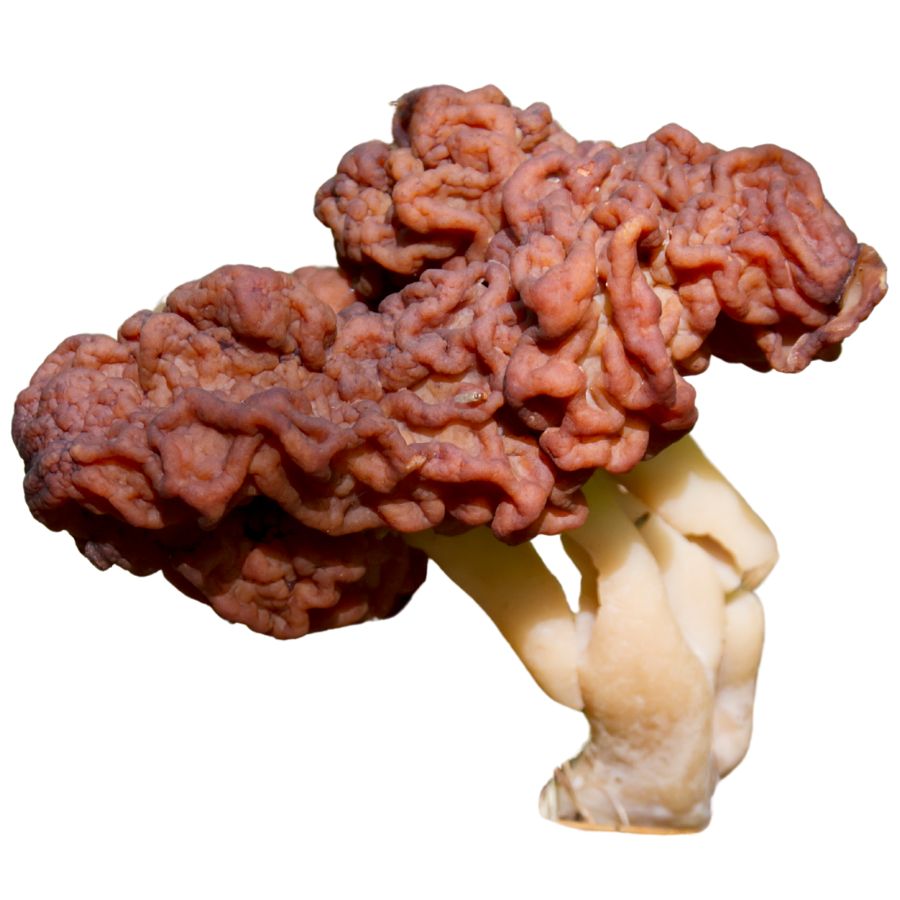
Often mistaken for: True morels (Morchella spp.)
False morels have wrinkled, lobed caps that look a bit like a brain or saddle, often reddish-brown or dark chestnut in color. Unlike true morels, their caps are usually irregular and hang over a thick, sometimes chambered stem.
These mushrooms contain toxic compounds like gyromitrin, which can turn into a chemical used in rocket fuel once inside the body. Eating them can lead to nausea, dizziness, seizures, or even liver failure in severe cases.
Jack-O’-Lantern (Omphalotus illudens)
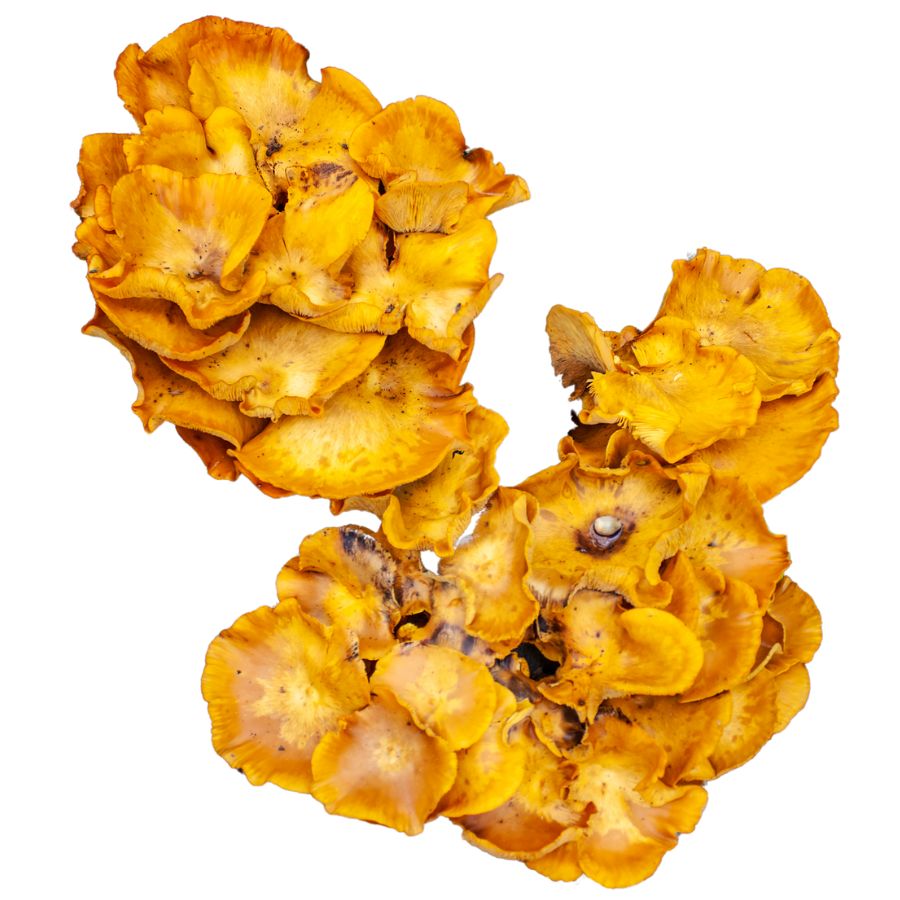
Often mistaken for: Chanterelles (Cantharellus spp.)
The jack-o’-lantern is a bright orange mushroom that grows in tight clusters, usually on decaying wood or buried tree roots. Its gills run down the stem and sometimes glow faintly in the dark due to natural bioluminescence.
These mushrooms are toxic and can cause severe stomach cramps, vomiting, and diarrhea. While not deadly, the symptoms can last for more than a day and are intense enough to require medical attention.
Green-Spored Parasol (Chlorophyllum molybdites)
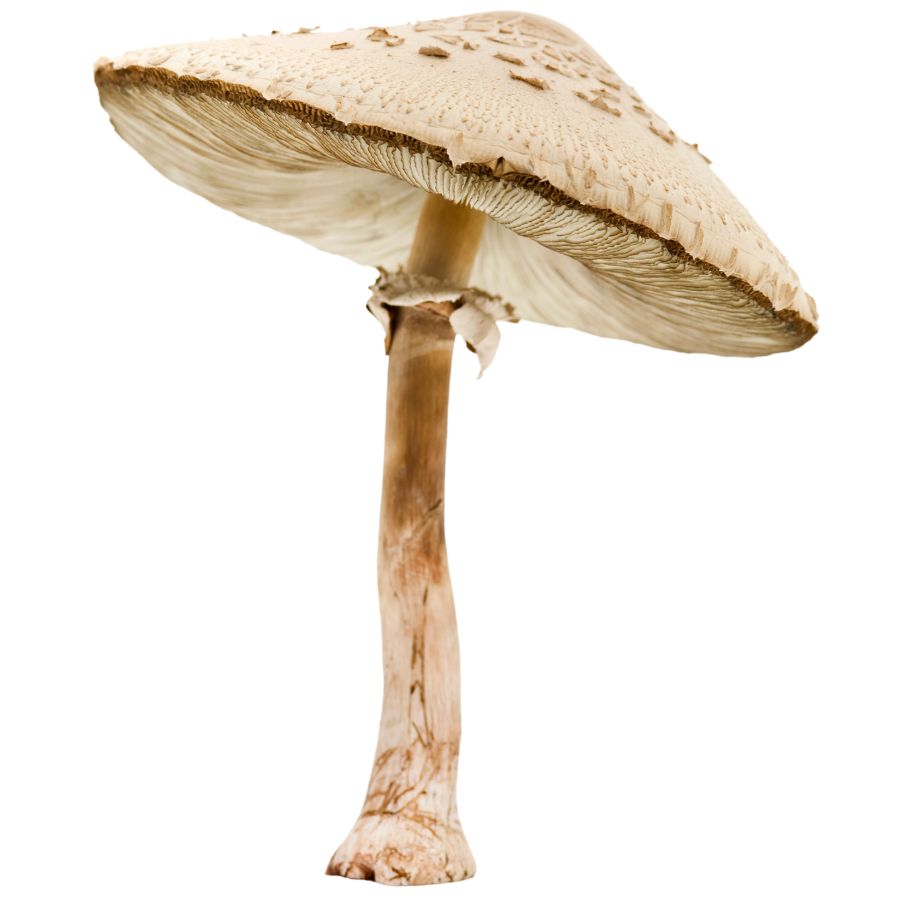
Often mistaken for: Meadow mushrooms (Agaricus campestris)
The green-spored parasol is a large, white mushroom with a wide, flat cap covered in brownish scales and a thick stem with a noticeable ring. When mature, its gills turn grayish-green and drop a green spore print, which is one of its most recognizable features.
This mushroom is toxic and causes intense gastrointestinal distress, including vomiting and diarrhea that can last for hours. While not fatal, it’s one of the most commonly reported causes of mushroom poisoning in the United States.
Eastern Destroying Angel (Amanita bisporigera)
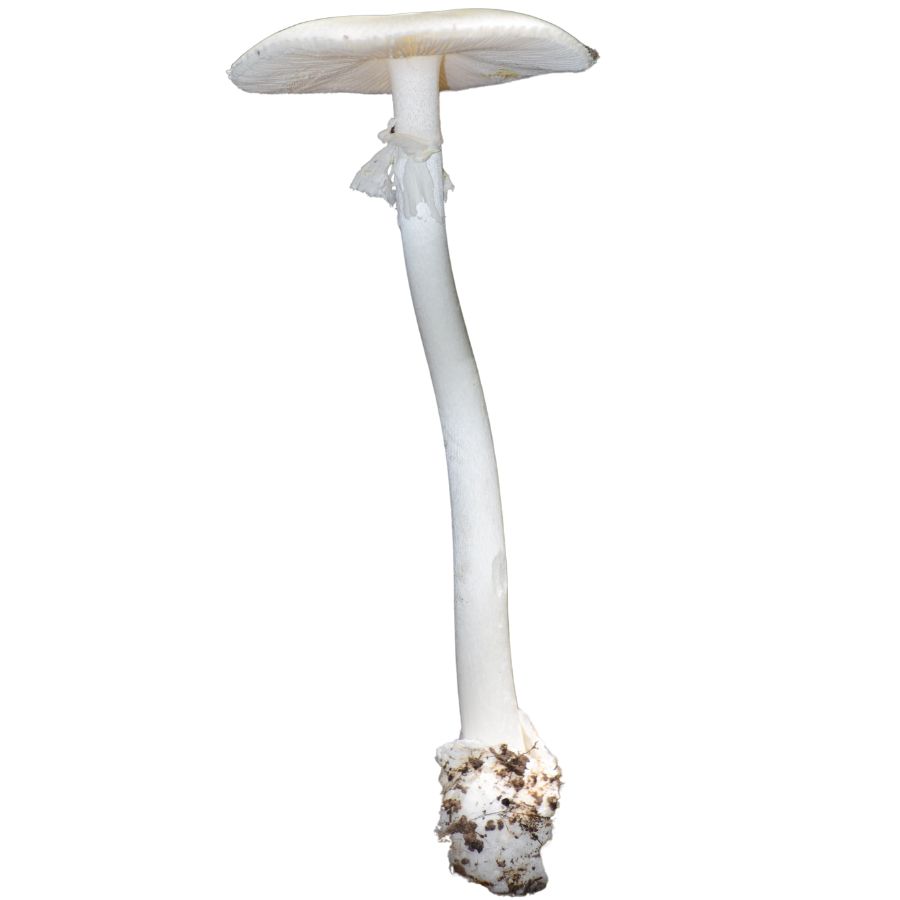
Often mistaken for: Young button mushrooms (Agaricus spp.)
The eastern destroying angel is a pure white mushroom with a smooth cap, white gills, and a slender stem that ends in a swollen base wrapped in a cup-like sac. It also has a thin ring near the upper part of the stem, a feature common to many toxic Amanitas.
What makes this mushroom so dangerous is its amatoxins, which attack the liver and kidneys and can be fatal if not treated quickly. Just one cap is enough to cause severe organ failure, and symptoms may take hours to appear.
Lilac Brown Cort (Cortinarius traganus)
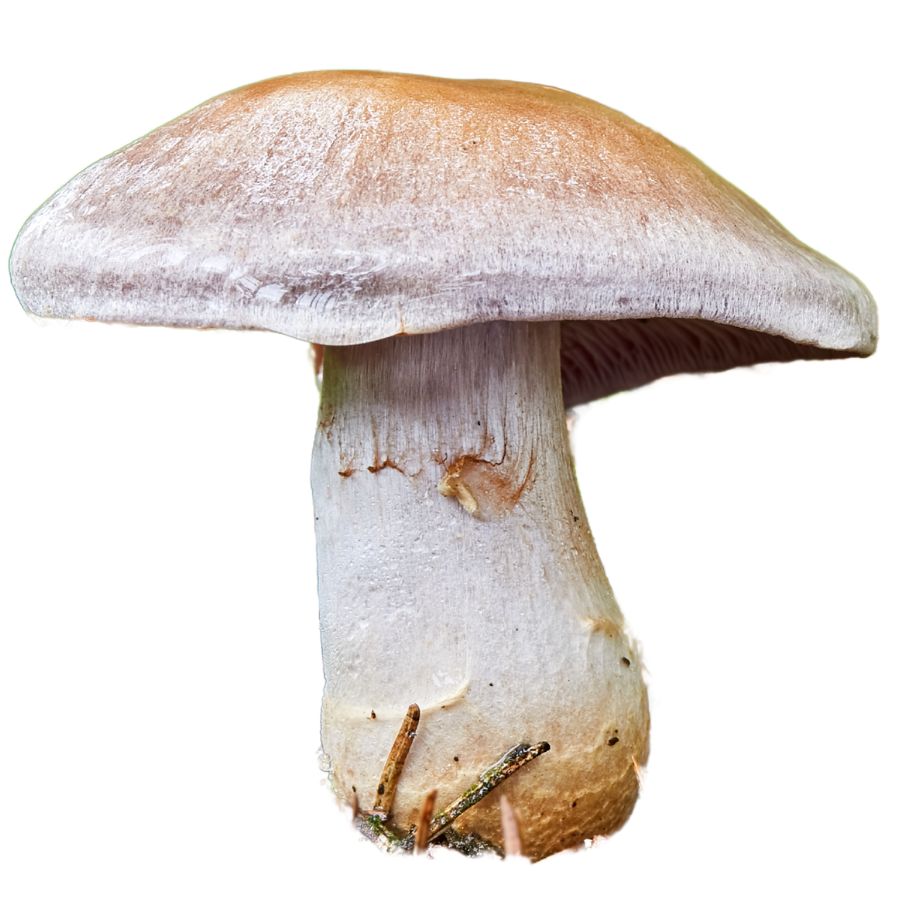
Often mistaken for: Blewits (Lepista nuda)
The lilac brown cort is a stocky mushroom with a violet to lilac cap that fades to brown as it ages, and a thick stem that often has rusty streaks from its spore dust. It gives off a strong, unpleasant odor that’s sometimes described to be similar to rotting laundry or rubber.
This mushroom is inedible and potentially toxic, with compounds that may harm the kidneys over time. It’s not considered deadly, but eating it can lead to serious long-term health problems if consumed in quantity.
Pigskin Poison Puffball (Scleroderma citrinum)
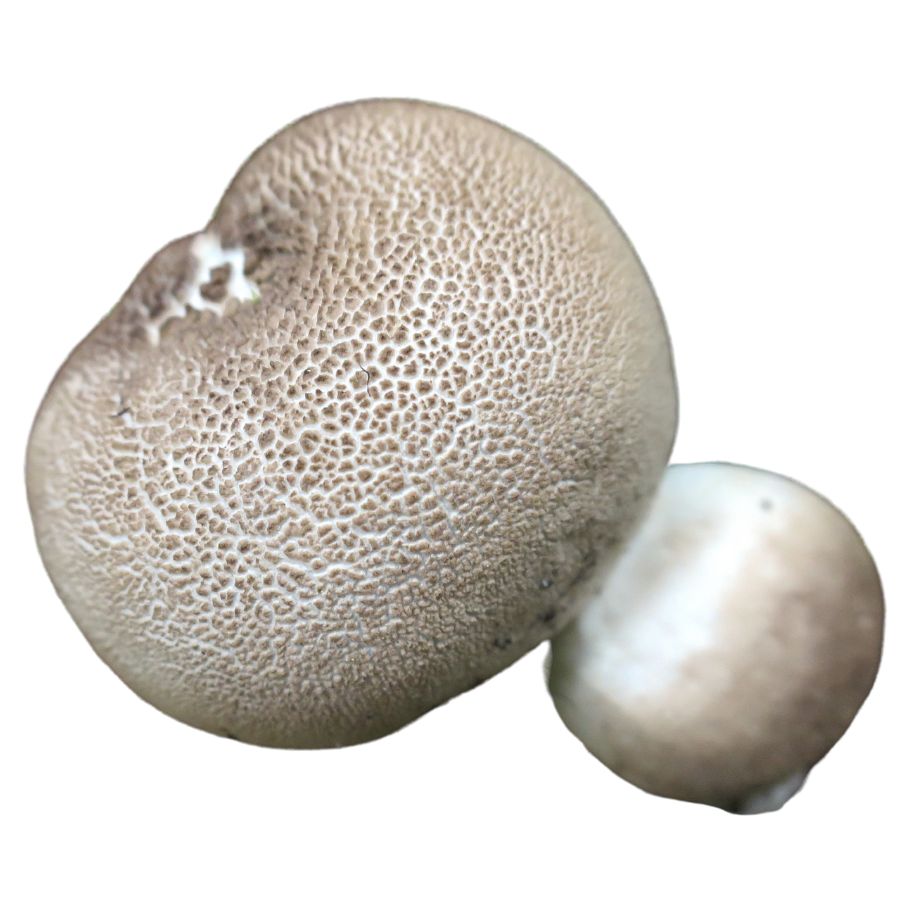
Often mistaken for: Common puffball (Lycoperdon perlatum)
The pigskin poison puffball is a round, tough-skinned mushroom with a warty, speckled surface that can be yellowish to brown. When cut open, the inside is dark purplish-black, even when young, and never pure white.
This mushroom is inedible and toxic, causing nausea, vomiting, and other digestive issues if eaten. The name “pigskin” is fitting—it’s thick, rubbery, and a good sign to leave it alone.
How to Find Edible Mushrooms in the State
Knowing how to recognize promising habitats is key to finding edible species consistently. Different mushrooms prefer different environments, so understanding regional ecosystems, seasonal shifts, and habitat markers can help you locate fruitful spots faster.
Focus on Hardwoods and Conifers
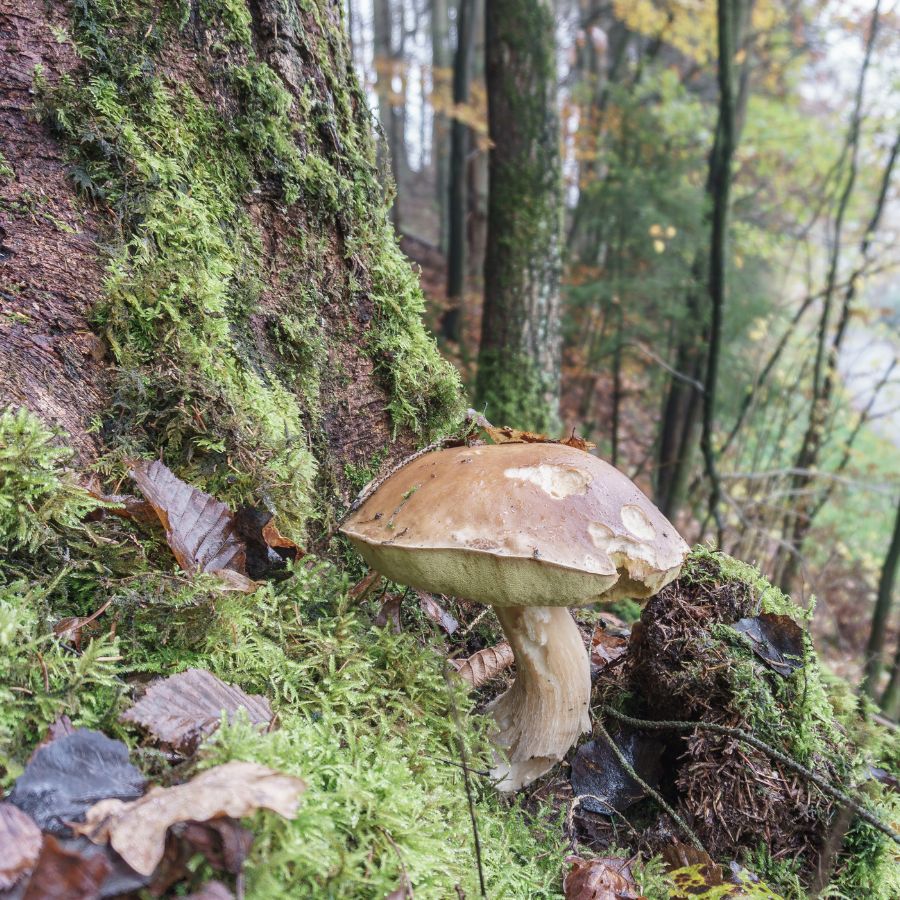
Many prized edible mushrooms grow in symbiosis with certain trees. Morels, for example, are often found near dead or dying elms, ash, sycamores, or old apple orchards. Chanterelles favor hardwood forests with oaks and beeches, while porcini are commonly linked to pines and spruces.
Mixed woodlands tend to offer the most variety. Areas with both conifers and deciduous trees often support overlapping species that fruit in different parts of the season. Pay attention to forest age as well, as mature woods with minimal underbrush are generally more productive than overgrown thickets.
Look Near Moss, Leaf Litter, and Stream Banks

Moisture plays a big role in where mushrooms fruit. Low-lying areas that retain water but don’t flood are especially good after recent rains. Mossy patches, seeps, and forested stream banks often support dense flushes of mushrooms. However, too much standing water or swampy terrain can favor molds and rot rather than edible fungi.
Look for slopes that receive filtered sunlight and have leaf litter, decaying wood, and rich soil. These spots hold humidity well without being saturated. South-facing hillsides may dry out too quickly, while north-facing ones tend to stay cool and damp longer.
Look in Burn Sites, Logging Sites, and Old Homesteads

Some mushrooms thrive in disturbed habitats. Morels in particular often appear in the first or second spring after a forest fire. Burned pine or mixed conifer areas in the Western US are well-known hotspots for black morels. Logging areas, floodplains, and even old homesteads with disturbed soil can also produce mushrooms.
Search around the edges of burned zones rather than in the center. Slightly scorched areas with remaining tree cover tend to be the most productive. Keep in mind that some species that fruit in disturbed areas appear quickly and then disappear just as fast.
Foraging isn’t just a pastime—it’s a skill that can help you get through the unexpected. Knowing how to forage for survival can turn wild plants into life-saving resources.
Track Rain and Temperature to Time Your Hunt
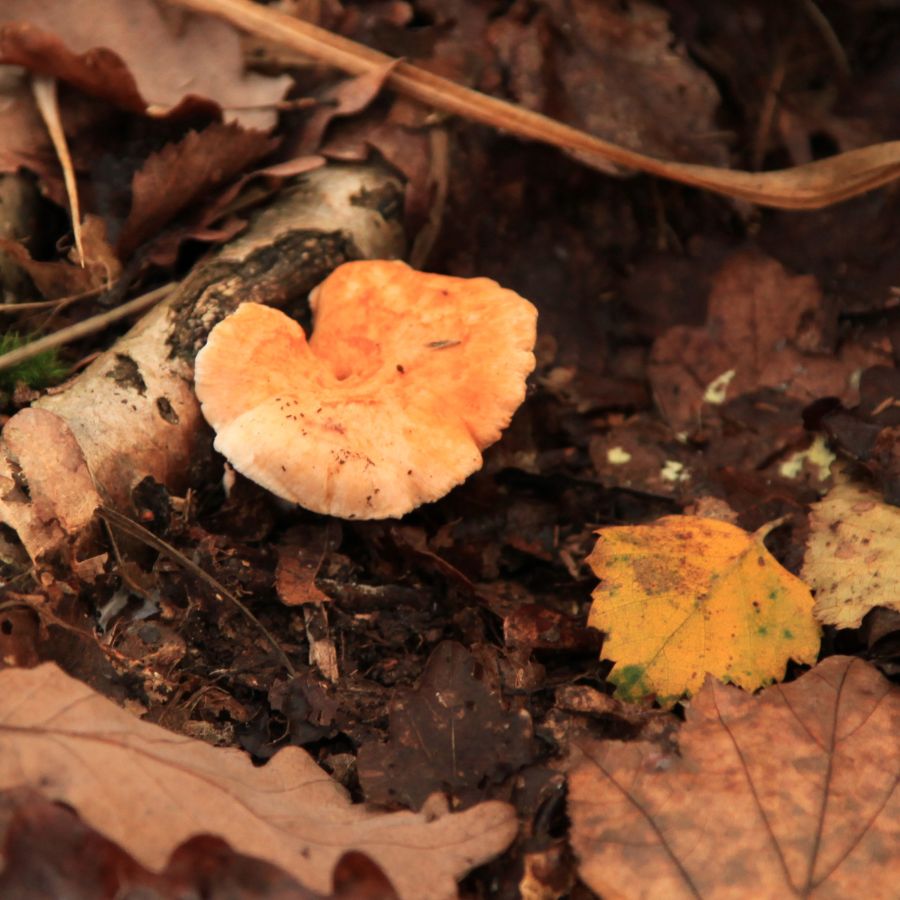
Timing is everything in mushroom foraging. Coastal states like California and Oregon may see chanterelles and hedgehogs during the wet winter months, while morels appear in springtime across much of the Midwest and Northeast. In mountainous regions, elevation plays a major role—start low in early spring and move higher as the season progresses.
Snowmelt often triggers fruiting in alpine zones. In places like Colorado or Utah, late spring and early summer are ideal for high-altitude species. Track temperature and rainfall patterns to adjust your search elevation accordingly.
You can find more wild spring edibles that are some of the first—and best—plants to forage each year.
Search Along Forest Borders, Fallen Logs, and Game Paths
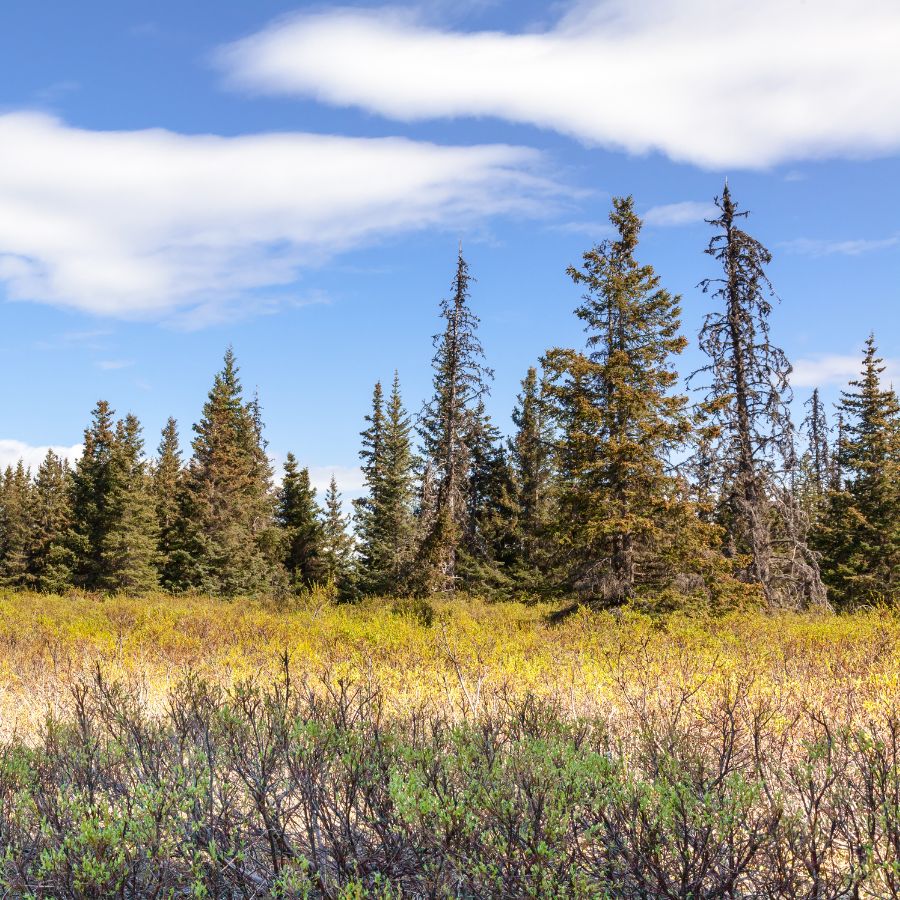
The edge between two environments, like a forest meeting a meadow, is often more productive than either area alone. These transition zones create a variety of light, moisture, and soil conditions that support different fungi. Old trails, game paths, and fallen logs also form microhabitats worth checking.
Keep an eye out for subtle clues like insect activity, animal scat, or clusters of saplings—these often indicate rich, undisturbed organic matter below. Fungi thrive where decay, diversity, and moisture converge, so train yourself to spot those overlaps.
Start With Familiar Mushroom Species

If you’re just starting out, pick one or two edible mushrooms that grow in your region and take the time to study them closely. Learn how they look in different stages of growth, what kind of environments they prefer, and what other mushrooms they might be confused with.
Don’t rely on just one photo or app to make an identification. Use field guides, online forums, and regional books together to cross-check what you’ve found and avoid mistakes.
These easy-to-identify edible mushrooms are easiest to spot and safest to harvest.
Learn the Right Tools and Techniques for Mushroom ID
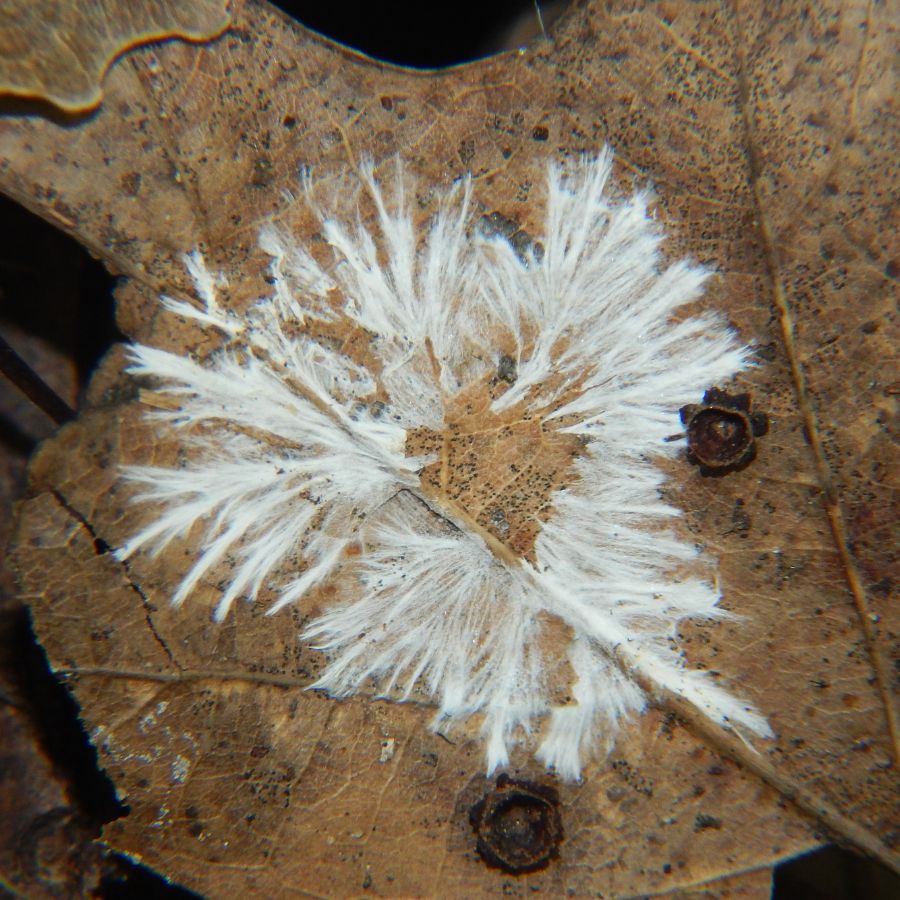
Accurate mushroom identification takes more than a quick glance or a smartphone scan. Learn how to take spore prints and pay close attention to gill attachment, cap texture, stem shape, and color changes.
Some mushrooms look nearly identical but differ in key microscopic or structural details. Old myths like “if animals eat it, it’s safe” or “white mushrooms aren’t poisonous” can lead to serious mistakes and should never be trusted.
A few simple foraging tools can help you gather more, damage less, and stay prepared in the field.
Only Eat Mushrooms You Can Identify With Absolute Certainty

If you’re not completely sure about a mushroom, it’s best to leave it behind. A single bite of the wrong species can lead to serious illness or even be fatal.
Many toxic mushrooms closely mimic popular edible ones, and the differences can be subtle. Learn which poisonous species grow in your area so you can recognize them before you ever pick.
Forage Away from Roads, Lawns, and Industrial Sites

Mushrooms can soak up heavy metals, pesticides, and other pollutants from the ground where they grow. Stay away from roadsides, treated lawns, or any area near industrial activity.
If you choose to eat foraged mushrooms, always save a few raw pieces in a paper bag in the fridge. This can help doctors quickly identify the species if you start to feel sick.
You don’t have to go too far if you want to forage safely. You might be surprised how many edible suburban plants are hiding in plain sight around your neighborhood.
Check Local Foraging Rules Before You Start Collecting

Before collecting mushrooms, make sure to check the rules for the area you’re in—some public lands allow foraging, while others don’t. Regulations can vary widely between parks, forests, and preserves.
Spending time with experienced foragers can teach you things that books and photos don’t show. Local mushroom clubs and guided walks are great ways to build your skills and confidence.
A little knowledge goes a long way when it comes to safely harvesting wild food.
Before you head out
Before embarking on any foraging activities, it is essential to understand and follow local laws and guidelines. Always confirm that you have permission to access any land and obtain permission from landowners if you are foraging on private property. Trespassing or foraging without permission is illegal and disrespectful.
For public lands, familiarize yourself with the foraging regulations, as some areas may restrict or prohibit the collection of mushrooms or other wild foods. These regulations and laws are frequently changing so always verify them before heading out to hunt. What we have listed below may be out of date and inaccurate as a result.
Best Locations for Edible Mushrooms in the State
Some of the best spots for edible mushrooms are tied to very specific conditions. Knowing where to look and what typically grows in different locations can help narrow down your search.
Here are more of the state’s edible mushrooms and where you’re most likely to find them:
| Location | Edible Mushroom Species |
| Salt Point State Park | Golden Chanterelle (Cantharellus cibarius), California Golden Chanterelle (Cantharellus californicus), Yellowfoot (Cantharellus tubaeformis), King Bolete / Porcini (Boletus edulis), Queen Bolete (Boletus aereus), Black Trumpet (Craterellus cornucopioides), Hedgehog Mushroom (Hydnum repandum), Candy Cap (Lactarius rubidus), Black Morel (Morchella elata), Wood Blewit (Clitocybe nuda) |
| Point Reyes National Seashore | Meadow Mushroom (Agaricus campestris), Honey Mushroom (Armillaria mellea), California Golden Chanterelle (Cantharellus californicus), Candy Cap (Lactarius rubidus), Oyster Mushroom (Pleurotus ostreatus), Shaggy Mane (Coprinus comatus), Cauliflower Mushroom (Sparassis crispa), Short-Stemmed Slippery Jack (Suillus brevipes), Coccoli / Coccora (Amanita calyptrata) |
| Jackson Demonstration State Forest | California Golden Chanterelle (Cantharellus californicus), Golden Chanterelle (Cantharellus cibarius), White Chanterelle (Cantharellus subalbidus), King Bolete / Porcini (Boletus edulis), Queen Bolete (Boletus aereus), Candy Cap (Lactarius rubidus), Saffron Milk Cap (Lactarius deliciosus), Bleeding Milk Cap (Lactarius rubrilacteus), Pig’s Ears (Gomphus clavatus), Manzanita Bolete (Leccinum manzanitae), Hedgehog Mushroom (Hydnum repandum), Coccoli / Coccora (Amanita calyptrata) |
| Six Rivers National Forest | Golden Chanterelle (Cantharellus cibarius), Yellowfoot (Cantharellus tubaeformis), King Bolete / Porcini (Boletus edulis), Butter Bolete (Boletus appendiculatus), American Matsutake (Tricholoma magnivelare), Saffron Milk Cap (Lactarius deliciosus), Bleeding Milk Cap (Lactarius rubrilacteus), Pig’s Ears (Gomphus clavatus), Hedgehog Mushroom (Hydnum repandum) |
| Shasta-Trinity National Forest | American Matsutake (Tricholoma magnivelare), King Bolete / Porcini (Boletus edulis), Butter Bolete (Boletus appendiculatus), Black Morel (Morchella elata), Short-Stemmed Slippery Jack (Suillus brevipes), Cauliflower Mushroom (Sparassis crispa), Wine-Colored Slippery Jack (Chroogomphus vinicolor), Saffron Milk Cap (Lactarius deliciosus) |
| Klamath National Forest | Black Morel (Morchella elata), Golden Chanterelle (Cantharellus cibarius), Shaggy Mane (Coprinus comatus), Gem-Studded Puffball (Lycoperdon perlatum), King Bolete / Porcini (Boletus edulis), Oyster Mushroom (Pleurotus ostreatus), Short-Stemmed Slippery Jack (Suillus brevipes) |
| Mendocino National Forest | The Prince (Agaricus augustus), Blushing Wood Mushroom (Agaricus perobscurus), Honey Mushroom (Armillaria mellea), Queen Bolete (Boletus aereus), California Golden Chanterelle (Cantharellus californicus), Candy Cap (Lactarius rubidus), Coccoli / Coccora (Amanita calyptrata), Manzanita Bolete (Leccinum manzanitae), Wood Blewit (Clitocybe nuda), Deer Mushroom (Pluteus cervinus) |
| Tahoe National Forest | King Bolete / Porcini (Boletus edulis), Black Morel (Morchella elata), Short-Stemmed Slippery Jack (Suillus brevipes), Cauliflower Mushroom (Sparassis crispa), Velvet Foot / Enoki (Flammulina velutipes), Western Lion’s Mane (Hericium abietis), Bear’s Head Tooth (Hericium ramosum), Wine-Colored Slippery Jack (Chroogomphus vinicolor), Saffron Milk Cap (Lactarius deliciosus) |
| Plumas National Forest | King Bolete / Porcini (Boletus edulis), Butter Bolete (Boletus appendiculatus), Black Morel (Morchella elata), Short-Stemmed Slippery Jack (Suillus brevipes), Cauliflower Mushroom (Sparassis crispa), Velvet Foot / Enoki (Flammulina velutipes), Western Lion’s Mane (Hericium abietis), Bear’s Head Tooth (Hericium ramosum), Saffron Milk Cap (Lactarius deliciosus) |
| Eldorado National Forest | King Bolete / Porcini (Boletus edulis), Butter Bolete (Boletus appendiculatus), Black Morel (Morchella elata), Short-Stemmed Slippery Jack (Suillus brevipes), Cauliflower Mushroom (Sparassis crispa), Velvet Foot / Enoki (Flammulina velutipes), Western Lion’s Mane (Hericium abietis), Bear’s Head Tooth (Hericium ramosum), Wine-Colored Slippery Jack (Chroogomphus vinicolor) |
| Sierra National Forest | King Bolete / Porcini (Boletus edulis), Butter Bolete (Boletus appendiculatus), Black Morel (Morchella elata), Short-Stemmed Slippery Jack (Suillus brevipes), Cauliflower Mushroom (Sparassis crispa), American Matsutake (Tricholoma magnivelare), Velvet Foot / Enoki (Flammulina velutipes), Western Lion’s Mane (Hericium abietis), Bear’s Head Tooth (Hericium ramosum), Saffron Milk Cap (Lactarius deliciosus), Bleeding Milk Cap (Lactarius rubrilacteus) |
| Los Padres National Forest | California Golden Chanterelle (Cantharellus californicus), Golden Chanterelle (Cantharellus cibarius), Western Lion’s Mane (Hericium abietis), Lion’s Mane (Hericium erinaceus), Cypress Agaricus (Agaricus lilaceps), Coccoli / Coccora (Amanita calyptrata), Manzanita Bolete (Leccinum manzanitae), Western Chicken of the Woods (Laetiporus gilbertsonii), Blushing Morel (Morchella rufobrunnea) |
| Angeles National Forest | Golden Chanterelle (Cantharellus cibarius), Oyster Mushroom (Pleurotus ostreatus), Black Morel (Morchella elata), Blushing Morel (Morchella rufobrunnea), Western Chicken of the Woods (Laetiporus gilbertsonii), Meadow Mushroom (Agaricus campestris), Pavement Mushroom (Agaricus bitorquis) |
| San Bernardino National Forest | Horse Mushroom (Agaricus arvensis), Meadow Mushroom (Agaricus campestris), Portobello / Common Button Mushroom (Agaricus bisporus), Blushing Morel (Morchella rufobrunnea), Western Chicken of the Woods (Laetiporus gilbertsonii), Orange Peel Fungus (Aleuria aurantia), Gem-Studded Puffball (Lycoperdon perlatum), Short-Stemmed Slippery Jack (Suillus brevipes), Wine-Colored Slippery Jack (Chroogomphus vinicolor) |
| BLM Lands – Mother Lode Field Office Area (Sierra Foothills) | Meadow Mushroom (Agaricus campestris), The Prince (Agaricus augustus), Fairy Ring Mushroom (Marasmius oreades), Blushing Morel (Morchella rufobrunnea), Orange Peel Fungus (Aleuria aurantia), Queen Bolete (Boletus aereus), California Golden Chanterelle (Cantharellus californicus), Candy Cap (Lactarius rubidus), Manzanita Bolete (Leccinum manzanitae) |
Peak Mushroom Seasons
Mushroom seasons follow familiar patterns, but timing still depends heavily on local conditions. Soil moisture, temperature swings, and even wind patterns can all influence when species start to fruit.
Year-round
| Mushroom | Months | Best Weather Conditions |
| Portobello / Common Button Mushroom (Agaricus bisporus) | All months | Moist and disturbed environments, often cultivated |
Spring
As temperatures rise and moisture returns, a variety of edible mushrooms begin to fruit in forests and fields:
| Mushroom | Months | Best Weather Conditions |
| Black Morel (Morchella elata) | March–May | Post-fire areas during warm wet spring |
| Blushing Morel (Morchella rufobrunnea) | March–May | Urban landscaped areas after warm spring rain |
| Deer Mushroom (Pluteus cervinus) | April–October | On moist, decaying hardwoods after rain |
| Fairy Ring Mushroom (Marasmius oreades) | April–October | Wet grassy fields and lawns |
| Meadow Mushroom (Agaricus campestris) | April–October | Moist grassy areas after rain |
| Pavement Mushroom (Agaricus bitorquis) | March–October | Urban areas after rain |
| Western Chicken of the Woods (Laetiporus gilbertsonii) | April–October | After rain on hardwood trees |
Summer
Summer foraging can be productive, with certain mushrooms favoring the warmer conditions of the season:
| Mushroom | Months | Best Weather Conditions |
| Butter Bolete (Boletus appendiculatus) | June–August | Moist soils and summer rain near mixed woods |
| Pig’s Ears (Gomphus clavatus) | June–August | Humid, shaded conifer forests |
| Golden Chanterelle (Cantharellus cibarius) | July–October | Damp soil with scattered summer rains |
| King Bolete / Porcini (Boletus edulis) | July–October | Warm days and rain in conifer forests |
| Manzanita Bolete (Leccinum manzanitae) | July–October | Under manzanita after summer rain |
| Queen Bolete (Boletus aereus) | July–October | Warm and wet summers in coastal forests |
| The Prince (Agaricus augustus) | July–October | Warm days with occasional moisture, near coast |
Fall
Fall is a great season for many edible mushrooms, with cool temperatures and steady moisture creating ideal conditions:
| Mushroom | Months | Best Weather Conditions |
| American Matsutake (Tricholoma magnivelare) | September–November | Cold snaps and wet soil under conifers |
| Comb Tooth (Hericium coralloides) | October–December | Moist conifer logs after rainfall |
| Bleeding Milk Cap (Lactarius rubrilacteus) | October–November | Wet weather in coniferous woods |
| Cauliflower Mushroom (Sparassis crispa) | September–November | Wet coniferous forests in cool fall weather |
| Cypress Agaricus (Agaricus lilaceps) | October–December | Moist soil under cypress after autumn rain |
| Gem-Studded Puffball (Lycoperdon perlatum) | September–November | Humid forest floors after rain |
| Honey Mushroom (Armillaria mellea) | September–November | After fall rains, near tree bases |
| Horse Mushroom (Agaricus arvensis) | September–November | Cool, damp weather after early fall rains |
| Lion’s Mane (Hericium erinaceus) | October–December | Cool and wet hardwood forests |
| Saffron Milk Cap (Lactarius deliciosus) | September–November | Under pine after early fall rain |
| Shaggy Mane (Coprinus comatus) | September–November | Moist disturbed soil, especially after rain |
| Short-Stemmed Slippery Jack (Suillus brevipes) | September–November | Under pine during wet autumn |
| Western Lion’s Mane (Hericium abietis) | October–December | Cool, wet weather with recent rain |
| White Chanterelle (Cantharellus subalbidus) | October–December | Cool, wet weather in Douglas-fir forests |
| Wine-Colored Slippery Jack (Chroogomphus vinicolor) | September–November | Under pine after fall rain |
| Candy Cap (Lactarius rubidus) | October–January | After early rains, cool forest floor |
| Orange Peel Fungus (Aleuria aurantia) | October–January | Moist disturbed soils |
| Oyster Mushroom (Pleurotus ostreatus) | October–February | Dead wood during cold wet spells |
| Wood Blewit (Clitocybe nuda) | November–January | Cold temperatures and steady moisture |
Winter
While many species go dormant, a few hardy mushrooms can still be found in the woods during winter:
| Mushroom | Months | Best Weather Conditions |
| Black Trumpet (Craterellus cornucopioides) | December–February | Moist oak and tanoak forests after rain |
| Blushing Wood Mushroom (Agaricus perobscurus) | December–February | Cool and wet conditions in urban parks |
| California Golden Chanterelle (Cantharellus californicus) | December–February | Soaked oak woodlands after heavy winter rains |
| Hedgehog Mushroom (Hydnum repandum) | December–February | Consistently wet forest conditions |
| Velvet Foot / Enoki (Flammulina velutipes) | December–February | Cold snaps and rotting wood |
| Yellowfoot (Cantharellus tubaeformis) | December–February | Rainy periods with consistent cool moisture |
| Coccoli / Coccora (Amanita calyptrata) | January–March | Moist oak woodlands with warming temperatures |
One Final Disclaimer
The information provided in this article is for general informational and educational purposes only. Foraging for wild plants and mushrooms involves inherent risks. Some wild plants and mushrooms are toxic and can be easily mistaken for edible varieties.
Before ingesting anything, it should be identified with 100% certainty as edible by someone qualified and experienced in mushroom and plant identification, such as a professional mycologist or an expert forager. Misidentification can lead to serious illness or death.
All mushrooms and plants have the potential to cause severe adverse reactions in certain individuals, even death. If you are consuming foraged items, it is crucial to cook them thoroughly and properly and only eat a small portion to test for personal tolerance. Some people may have allergies or sensitivities to specific mushrooms and plants, even if they are considered safe for others.
Foraged items should always be fully cooked with proper instructions to ensure they are safe to eat. Many wild mushrooms and plants contain toxins and compounds that can be harmful if ingested.

